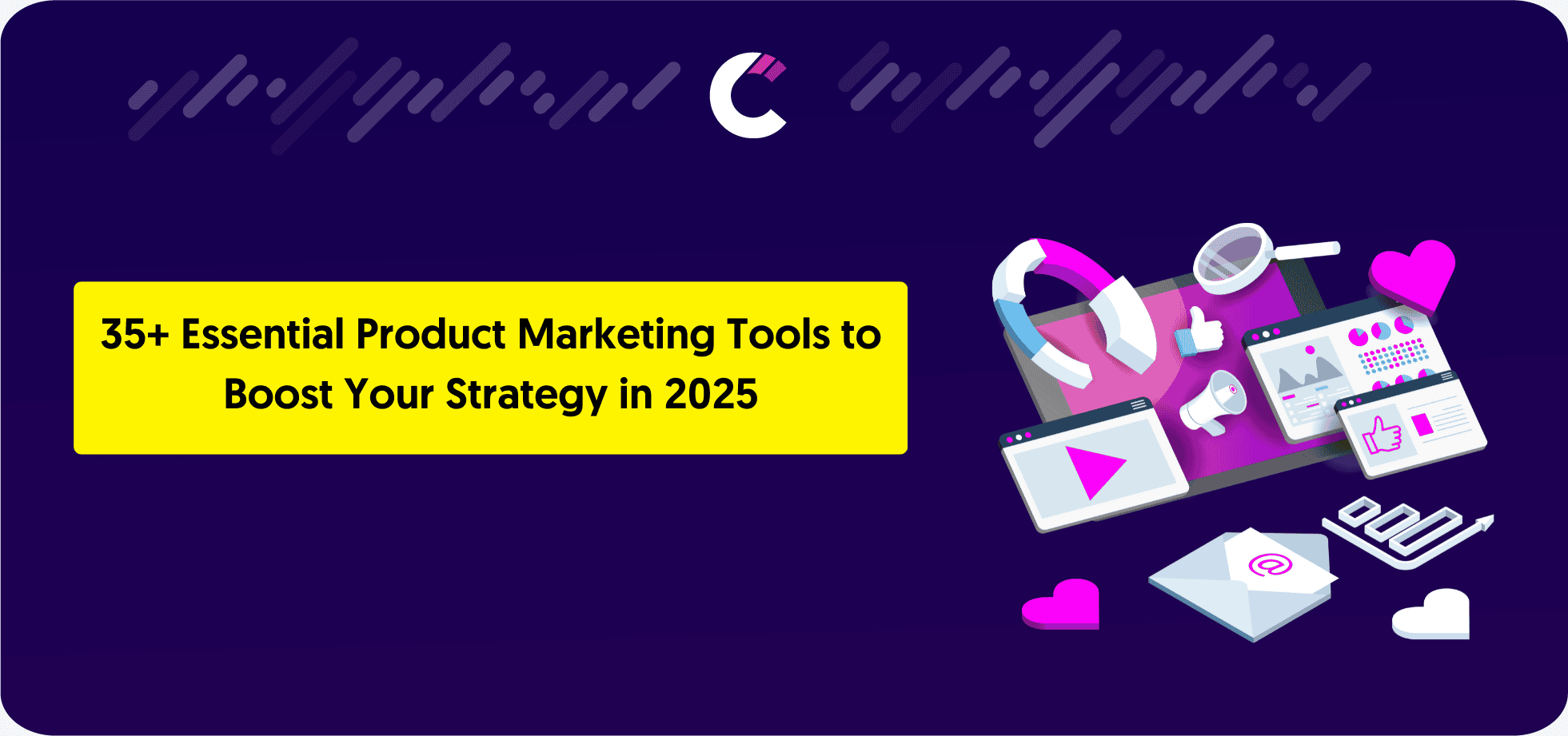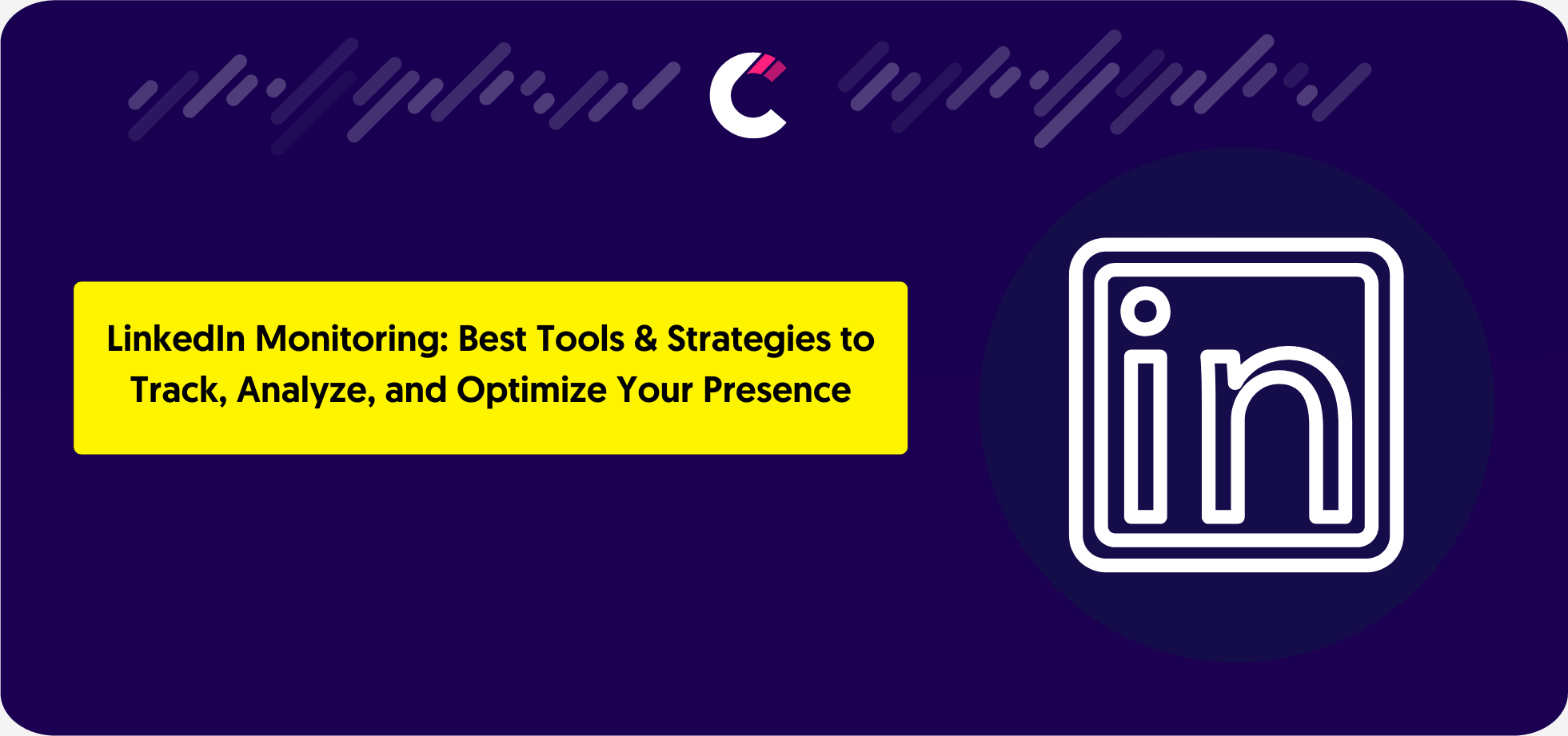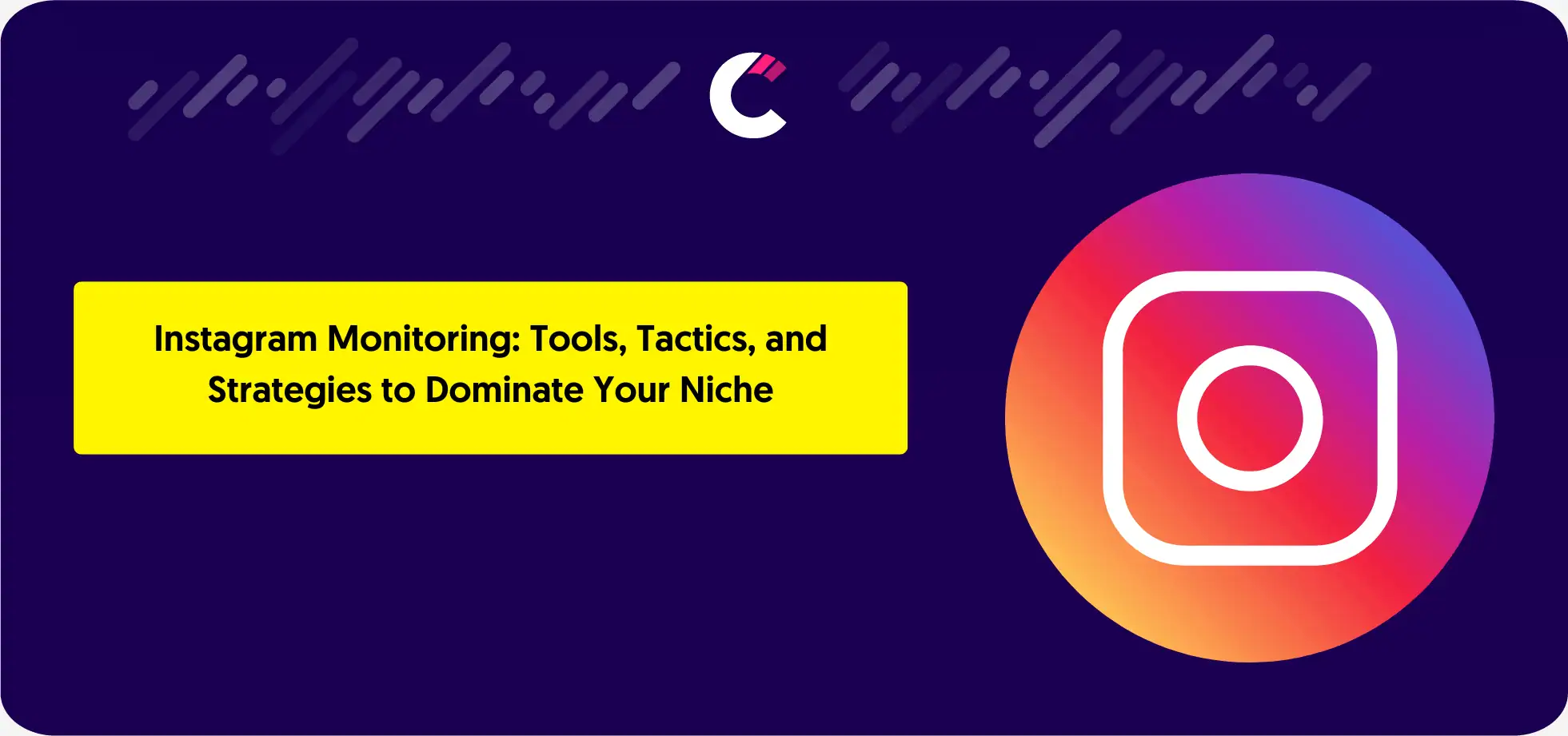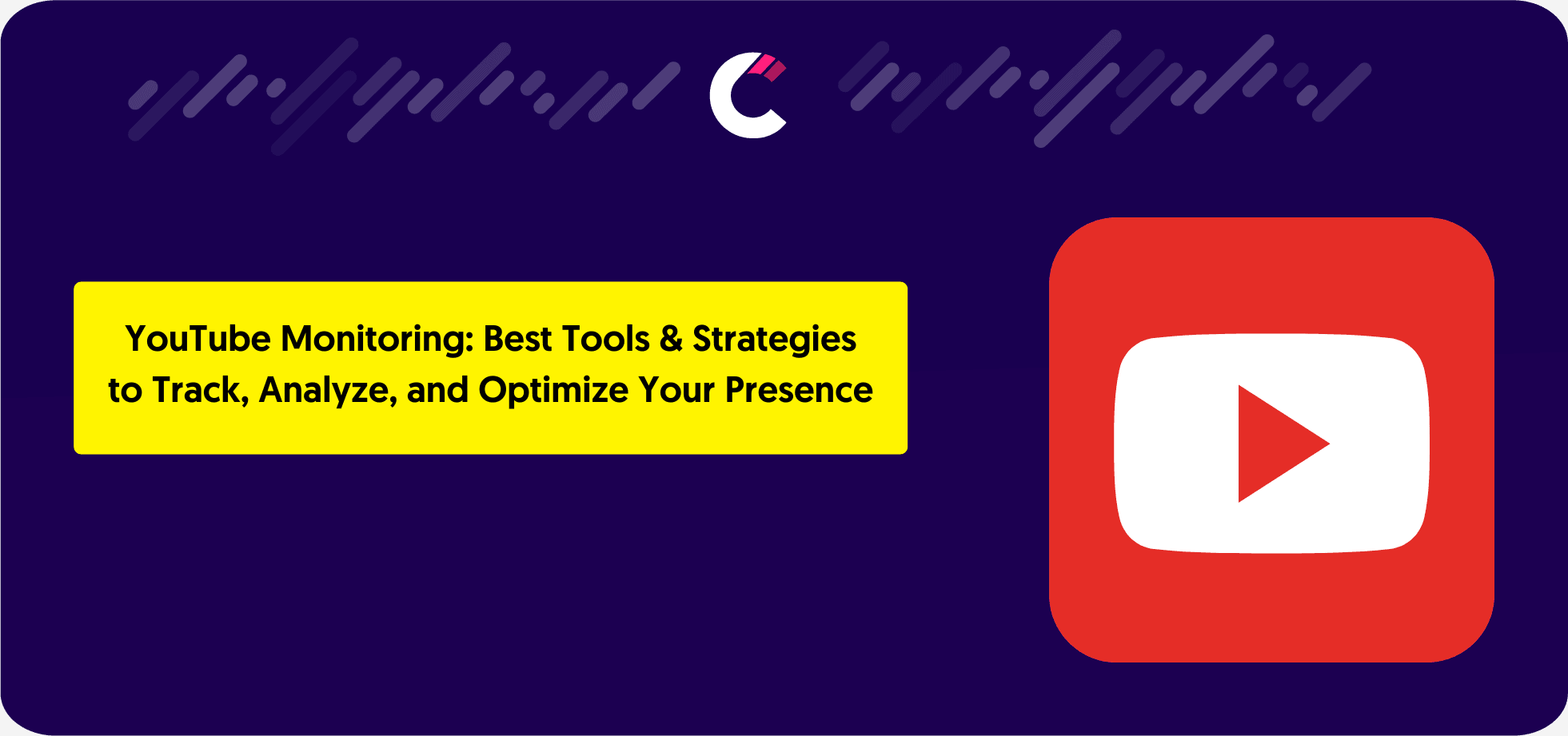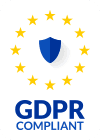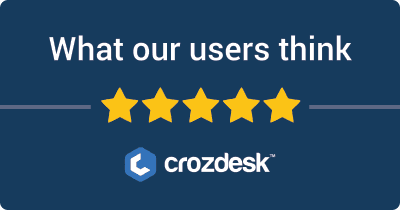TL;DR: Your Quick Guide to the Top Tools
- Competitors App — Best for competitive analysis and market research insights.
- ChatGPT — Best for AI-powered product marketing content and messaging.
- Hotjar — Best for capturing real-time user behavior and feedback.
- Slack — Best for seamless team collaboration and project management.
- Canva — Best for creating engaging, visually appealing marketing materials.
- HubSpot — Best for comprehensive marketing automation and customer engagement.
- Optimizely — Best for A/B testing and optimizing conversion rates.
- Miro — Best for communicating insights and mapping creative strategies.
- Tableau — Best for transforming complex data into interactive visualizations.
- Pendo — Best for assessing product market fit tools by tracking user engagement and adoption.
How We Review Tools at Competitors.app
At Competitors.app, our reviews are based on thorough testing and unbiased analysis. We carefully evaluate each product marketing tool for features, usability, and performance. We prioritize transparency and trust, so our recommendations are impartial and reflect our team’s genuine experience.
What Are Product Marketing Tools?
Definition of Product Marketing Tools
Product marketing tools are specialized software or platforms that help businesses promote their products, understand customer needs, and analyze market trends. They cover key functions such as campaign management, customer segmentation, and performance tracking.
Essentially, these tools take on complex tasks—sometimes even automating them—so that modern marketing teams can operate more efficiently and focus on strategy.
Why Product Marketing Tools Are Essential for Success
In today’s competitive landscape, product marketing tools aren’t just an add-on; they’re critical for growth. They enable you to collect real-time data, identify market opportunities, and fine-tune your marketing efforts for maximum impact. By automating routine tasks like email scheduling or report generation, they free up your team’s time to develop creative strategies that truly resonate with your audience. In short, these tools ensure that your campaigns remain data-driven and aligned with your overall business goals.
Key Features to Look for in Product Marketing Tools
When it comes to selecting the right tool, knowing what features will bring the most value to your business is key. Look for:
- Detailed Analytics: Insights that help you understand every facet of your campaigns.
- Easy Integration: Tools that seamlessly connect with your existing systems.
- Robust Customer Support: Reliable help when you need it.
- User-Friendly Design: Intuitive dashboards and customizable templates to save time and reduce learning curves.
- Scalability: The ability to grow with your team’s needs.
Categories of Product Marketing Software
Product marketing tools come in various categories, each serving a unique purpose. Here’s a quick rundown:
- Competitive Analysis and Market Research Tools: These tools help you monitor competitors and stay ahead of industry trends.
- AI Tools for Product Marketing: Ideal for automating tasks like content creation and personalizing campaigns—letting technology handle the heavy lifting.
- Tools for User Behaviour and Feedback: Gain insights into what your customers love or dislike by tracking their interactions and gathering feedback.
- Collaboration and Project Management Tools: Keep your team aligned and ensure no task slips through the cracks.
- Creativity and Content Curation Tools: From eye-catching visuals to engaging videos, these tools help your content stand out.
- Marketing Automation and Customer Engagement Tools: Automate repetitive tasks like email marketing while keeping your audience engaged.
- Tools for A/B Testing and Conversion Rate Optimisation: Experiment with different messages, designs, or strategies to see what works best.
- Tools for Communicating Insights: Easily share data and ideas across your team with tools designed for clear, visual communication.
- Data Analysis and Visualisation Tools: Dive deep into the numbers and present them in clear, digestible formats with interactive charts and graphs.
This refreshed approach not only explains what product marketing tools are and why they matter, but also breaks down the key features and categories in a natural, conversational tone—making it easy for readers to understand and engage with the content.
Competitive Analysis and Product Market Research Tools
Competitors App - The Best Tool for Competitive Insights
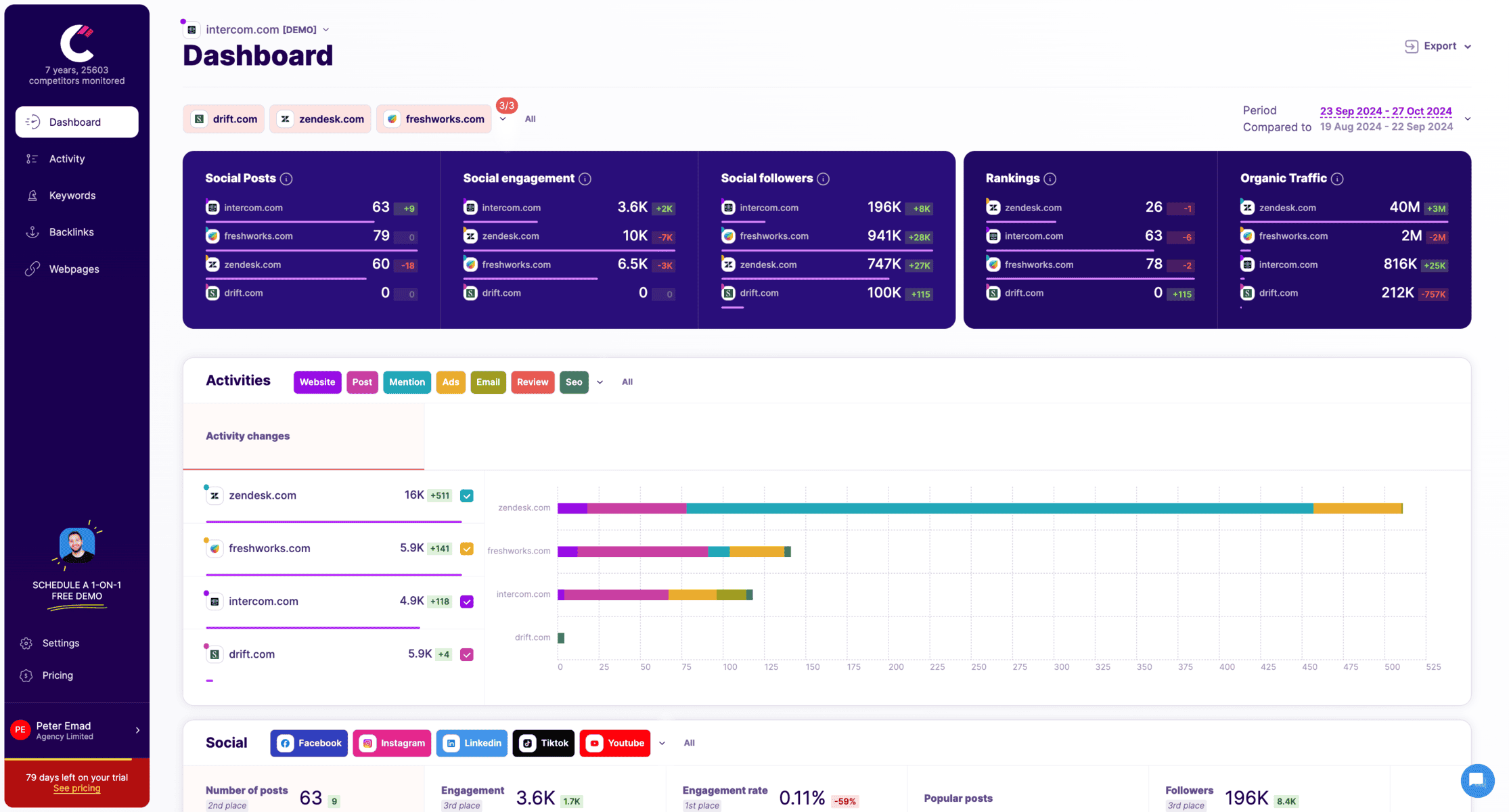
Competitor analysis is a cornerstone of successful product marketing, and Competitors App excels in providing businesses with detailed insights into their rivals’ strategies. This tool monitors competitor activity across websites, social media, and email campaigns, helping you identify trends and adjust your tactics accordingly.
- Key Features:
- Tracks updates on competitors’ websites and blogs.
- Monitors social media activities and engagement.
- Analyzes email marketing strategies from competitors.
- Generates regular reports with actionable insights.
- Advantages:
- Easy to use with automated tracking.
- Saves time on manual competitor research.
- Helps refine your marketing strategies with detailed reports.
- Disadvantages:
- Alerts can be overwhelming if not fine-tuned.
- Lacks integration with broader marketing tools.
- Pricing: Starting at $19.99/month, with higher tiers offering more features.
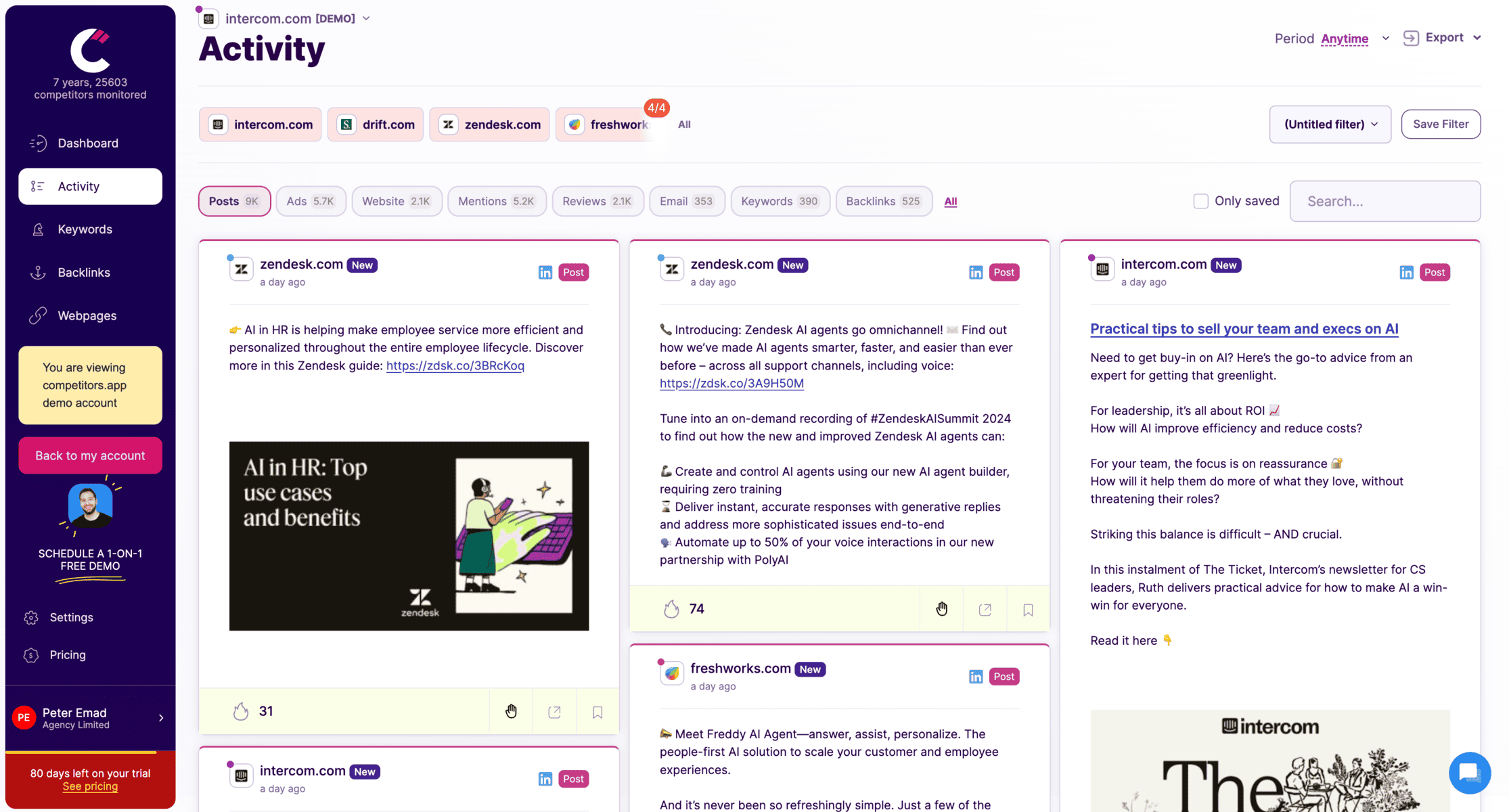
Tracks competitor social media updates across LinkedIn, Facebook, Twitter, and more.
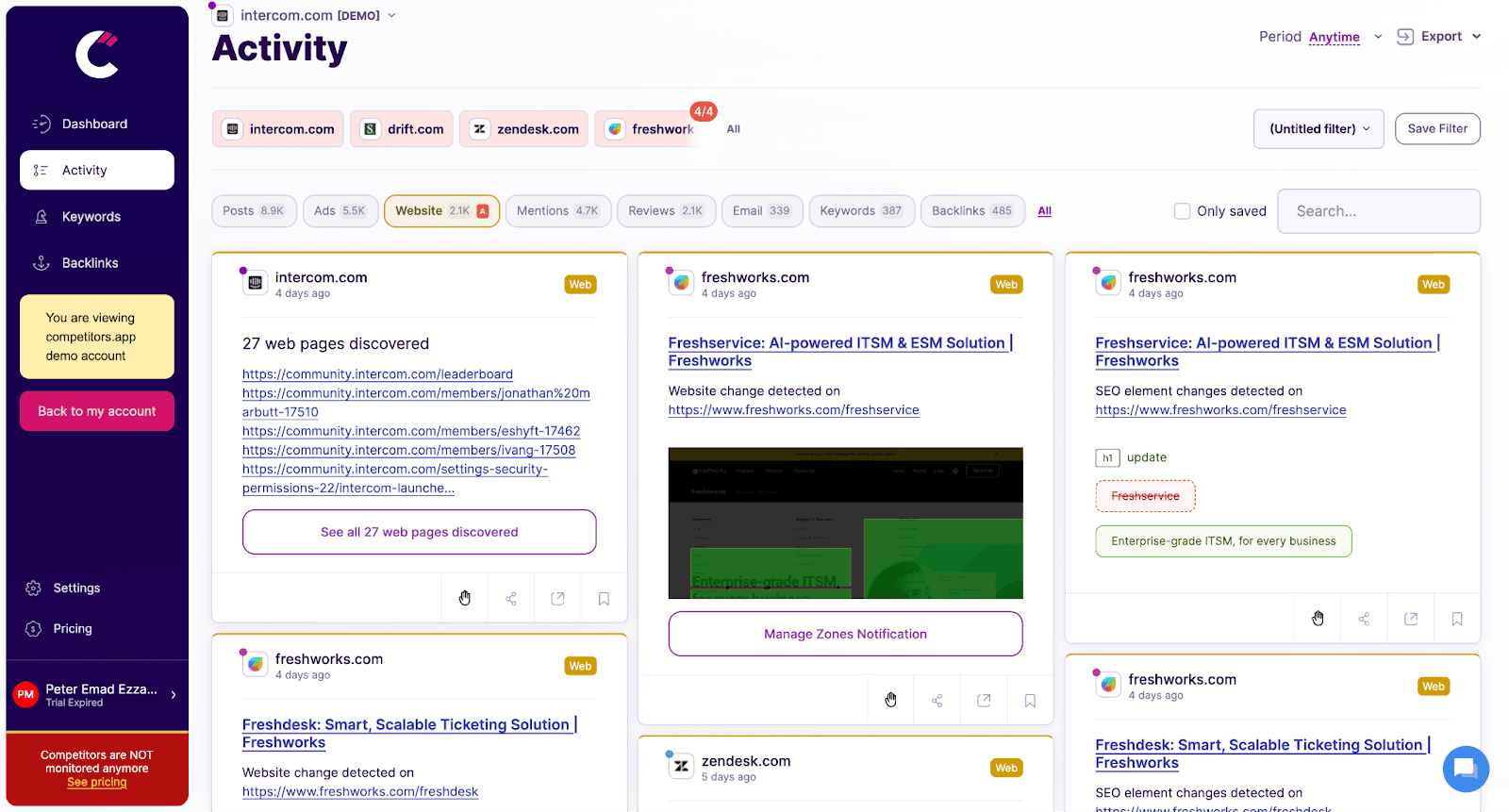
Monitors changes on competitors’ websites, such as product updates, pricing adjustments, and new messaging, providing instant alerts to help sales teams respond promptly.
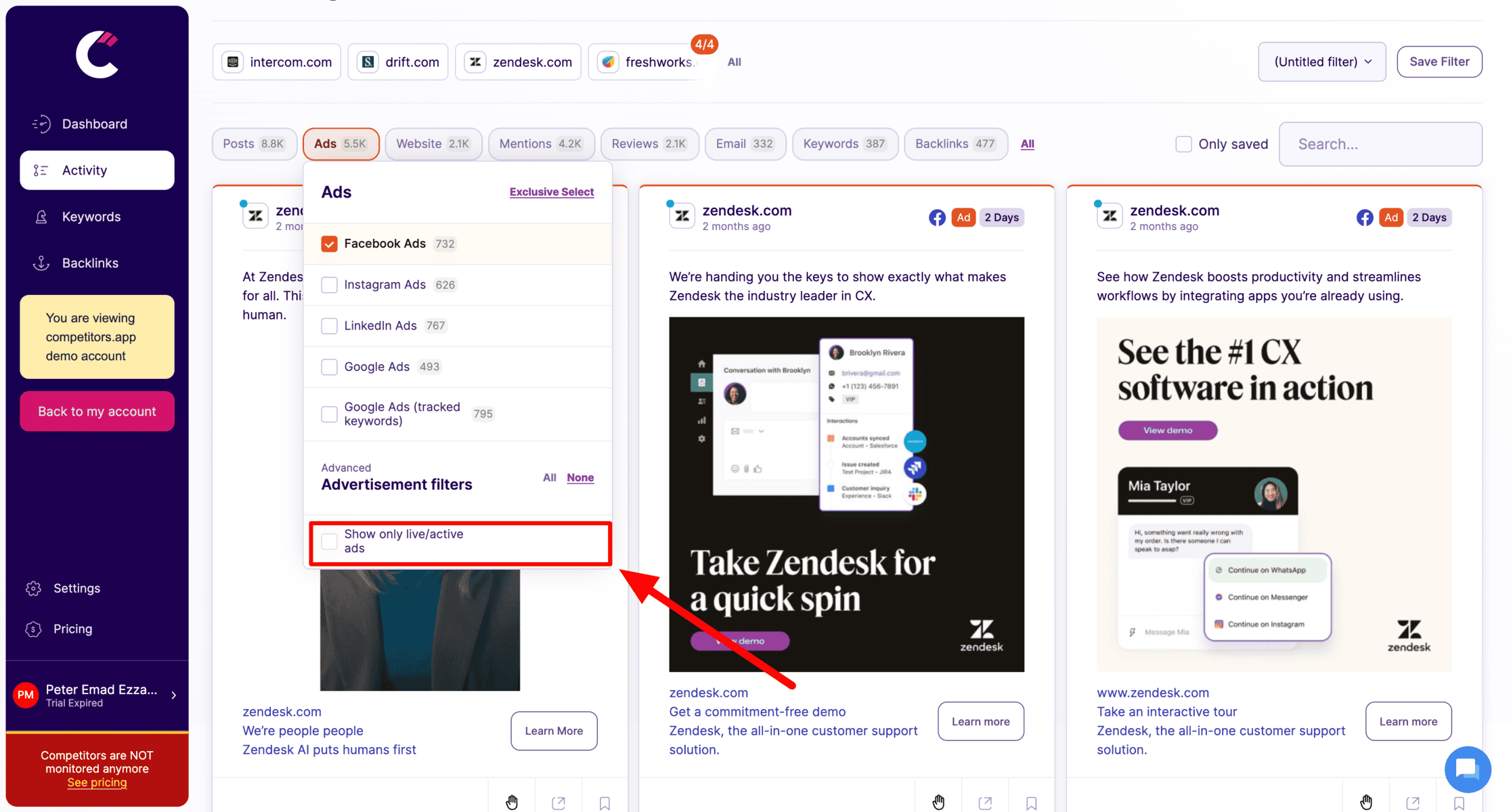
Tracks digital ad campaigns across platforms like Google Ads, Facebook, LinkedIn, and Instagram. It provides details on ad creatives, spending, and performance metrics, helping teams analyze successful ad strategies.

Analyzes competitors’ keyword strategies, organic rankings, and backlinks, allowing teams to refine their own SEO tactics and boost search visibility.
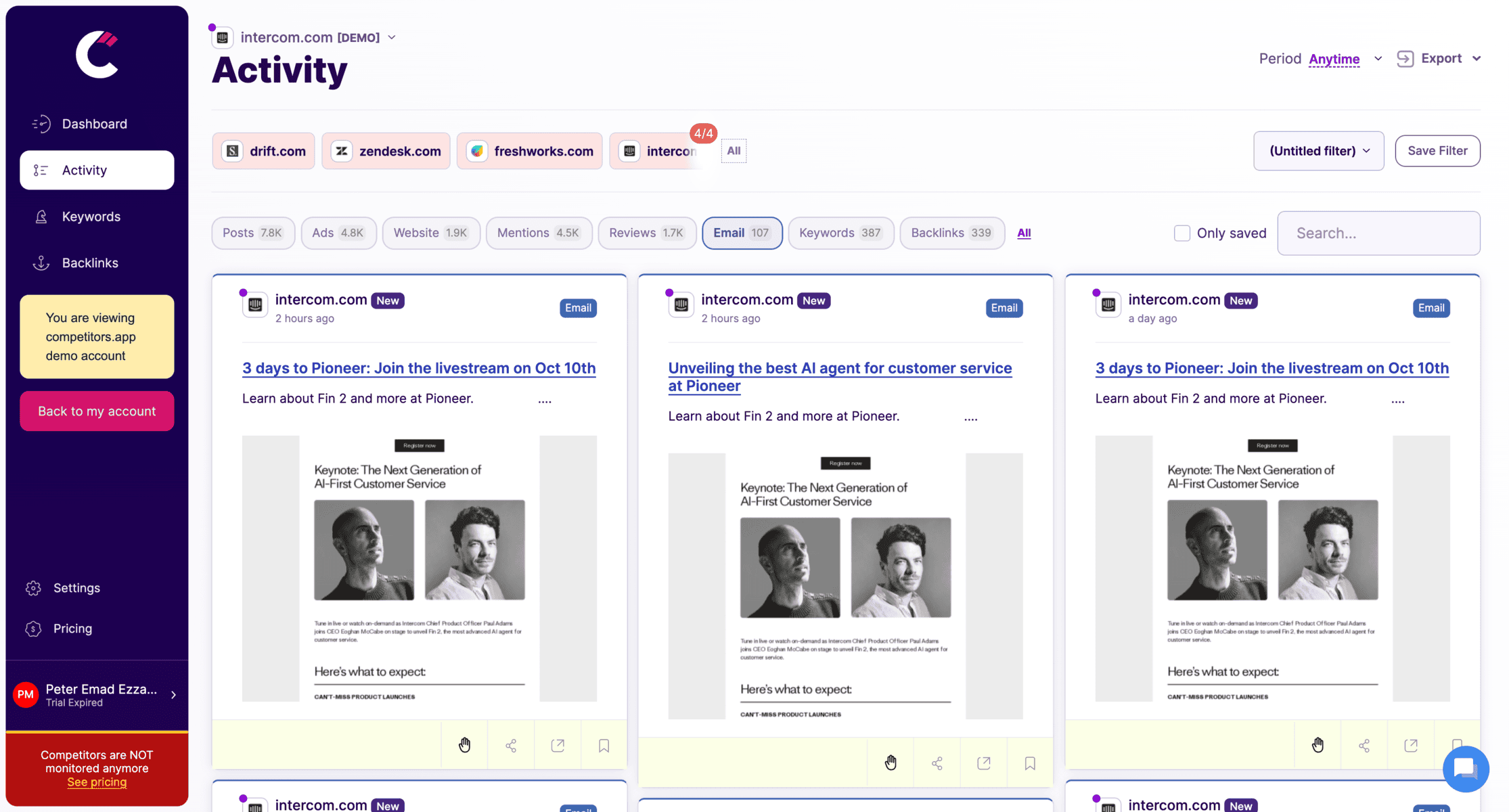
Tracks competitors’ email campaigns, including content, frequency, and engagement metrics, helping sales teams understand email tactics that drive engagement and conversions.
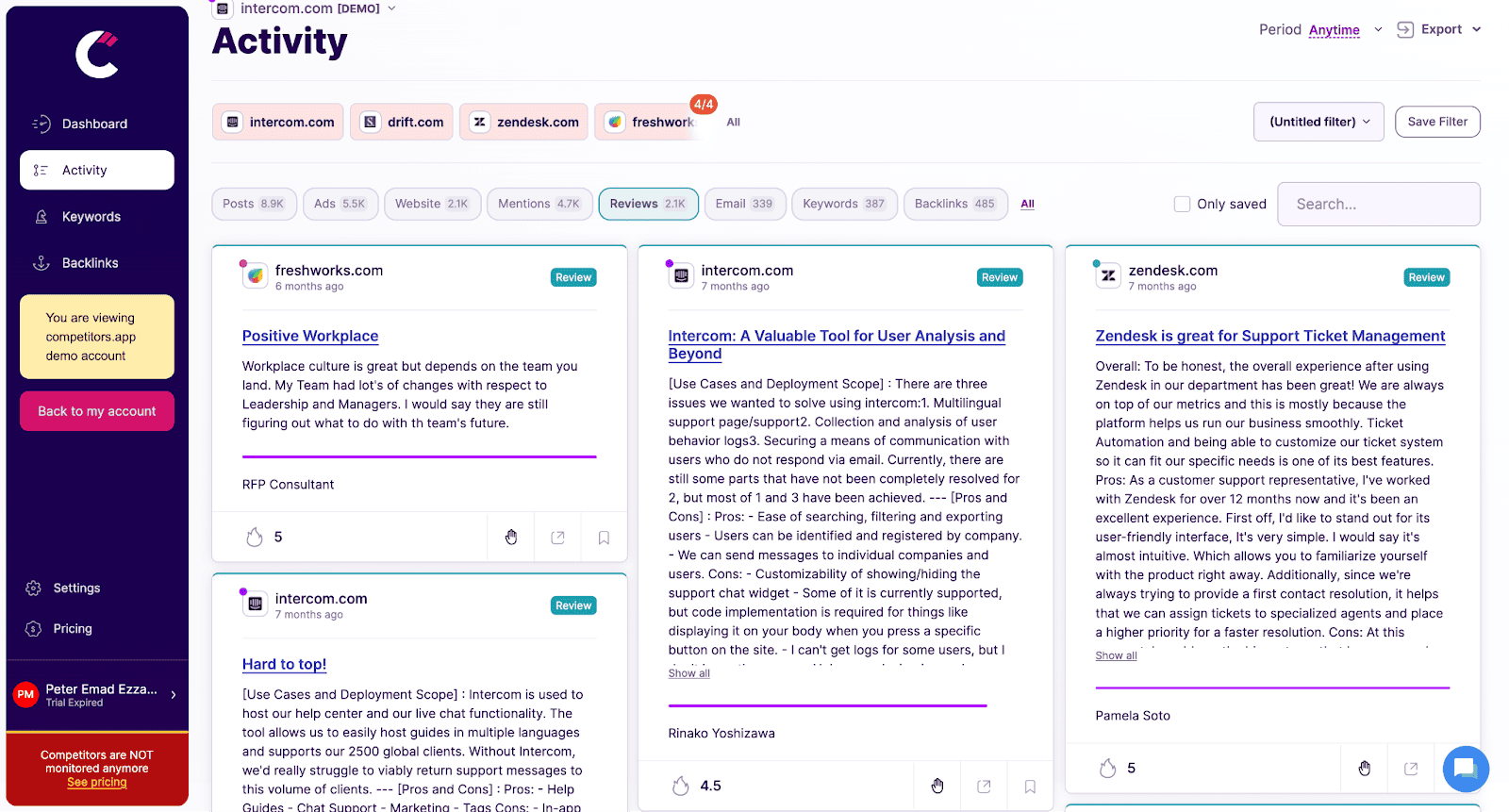
Analyzes customer reviews and ratings for competitors, providing insights into customer feedback, pain points, and product strengths, helping teams craft better sales pitches.
Crayon – Competitive Research Made Simple
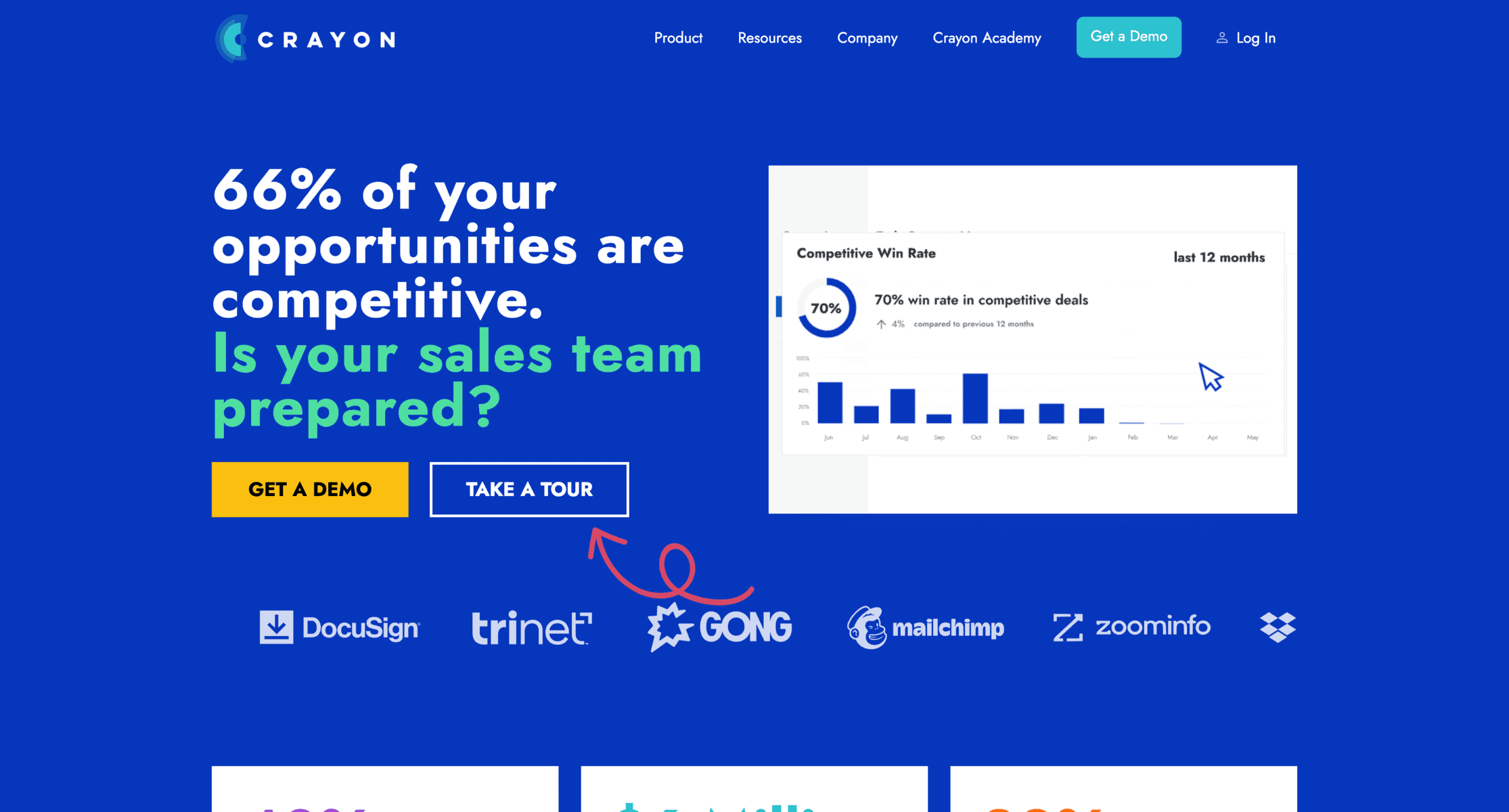
Staying ahead of competitors is vital in product marketing, and Crayon simplifies this process with its comprehensive competitive intelligence platform. It allows businesses to track competitor movements, from product updates to pricing changes, and gain actionable insights to refine their own strategies.
- Key Features:
- Tracks competitors’ websites, social media, and digital footprints.
- Provides real-time alerts for major changes or updates.
- Offers detailed analytics and visual dashboards.
- Allows customization to focus on specific competitors or industries.
- Advantages:
- Helps businesses identify market trends and emerging opportunities.
- Saves time with automated monitoring.
- Provides insights that can directly influence product positioning.
- Disadvantages:
- May require some time to configure alerts effectively.
- Focused primarily on competitive intelligence rather than broader market research.
- Pricing: Custom pricing based on business needs; typically starts with a consultation.
SEMrush – SEO and Competitor Analysis Tool
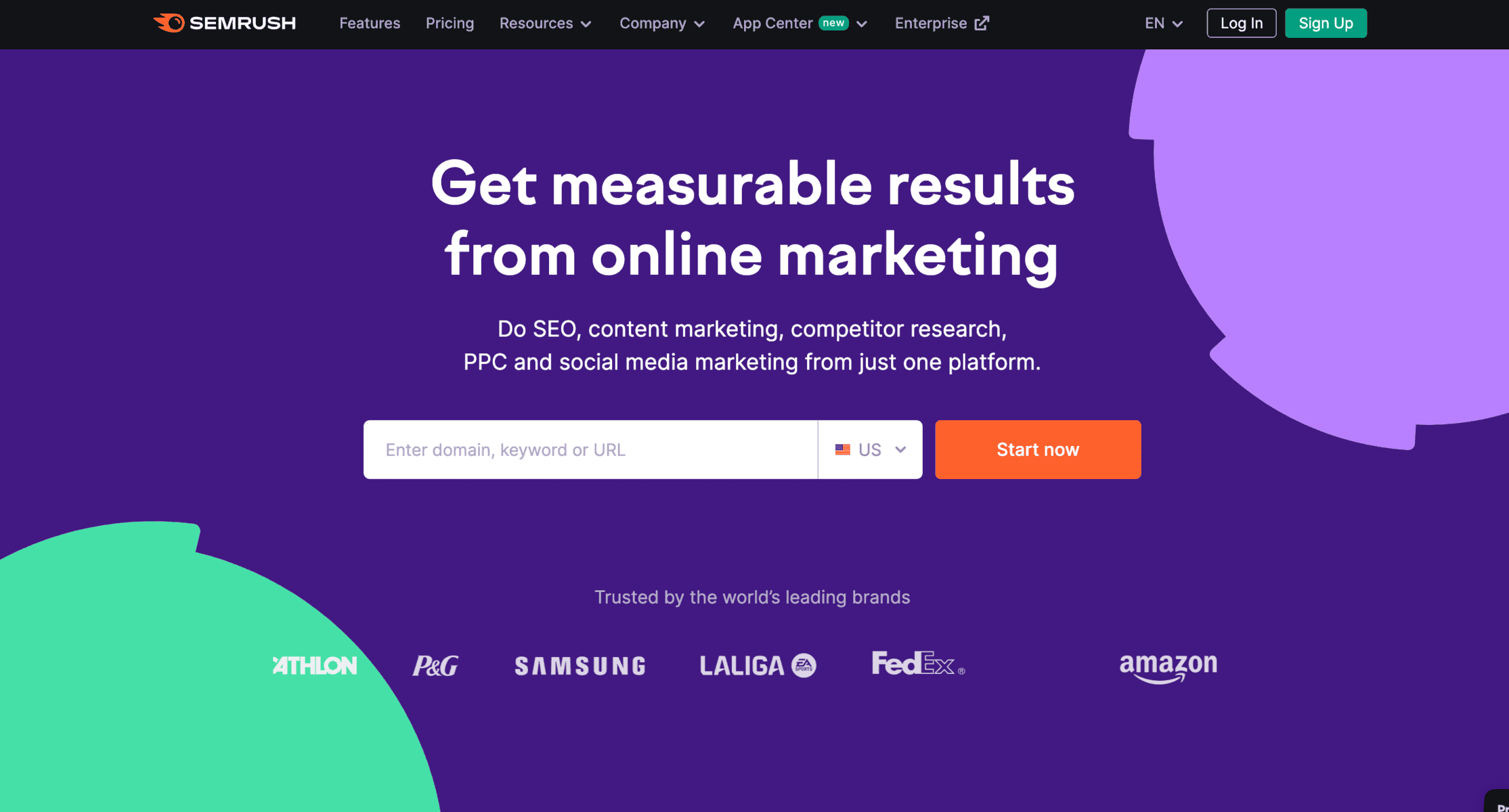
SEMrush is a versatile tool widely recognized for its ability to help businesses dominate search engine rankings and analyze competitors. Its robust feature set makes it a go-to platform for marketers who want to improve online visibility and gain a deep understanding of their market.
- Key Features:
- Comprehensive keyword research and tracking.
- Competitive domain analysis to evaluate rivals’ strategies.
- Site audit tools to optimize SEO performance.
- Content marketing toolkit for topic research and planning.
- Advantages:
- Offers an extensive database of keywords and analytics.
- Enhances content strategies with actionable SEO insights.
- Supports both organic and paid marketing efforts.
- Helps uncover opportunities in competitor weaknesses.
- Disadvantages:
- Advanced features can be overwhelming for beginners.
- Pricing may be steep for small businesses.
Pricing: Plans start at $129.95/month, with discounts for annual subscriptions.
Ahrefs – Insights for Target Market SEO Strategies
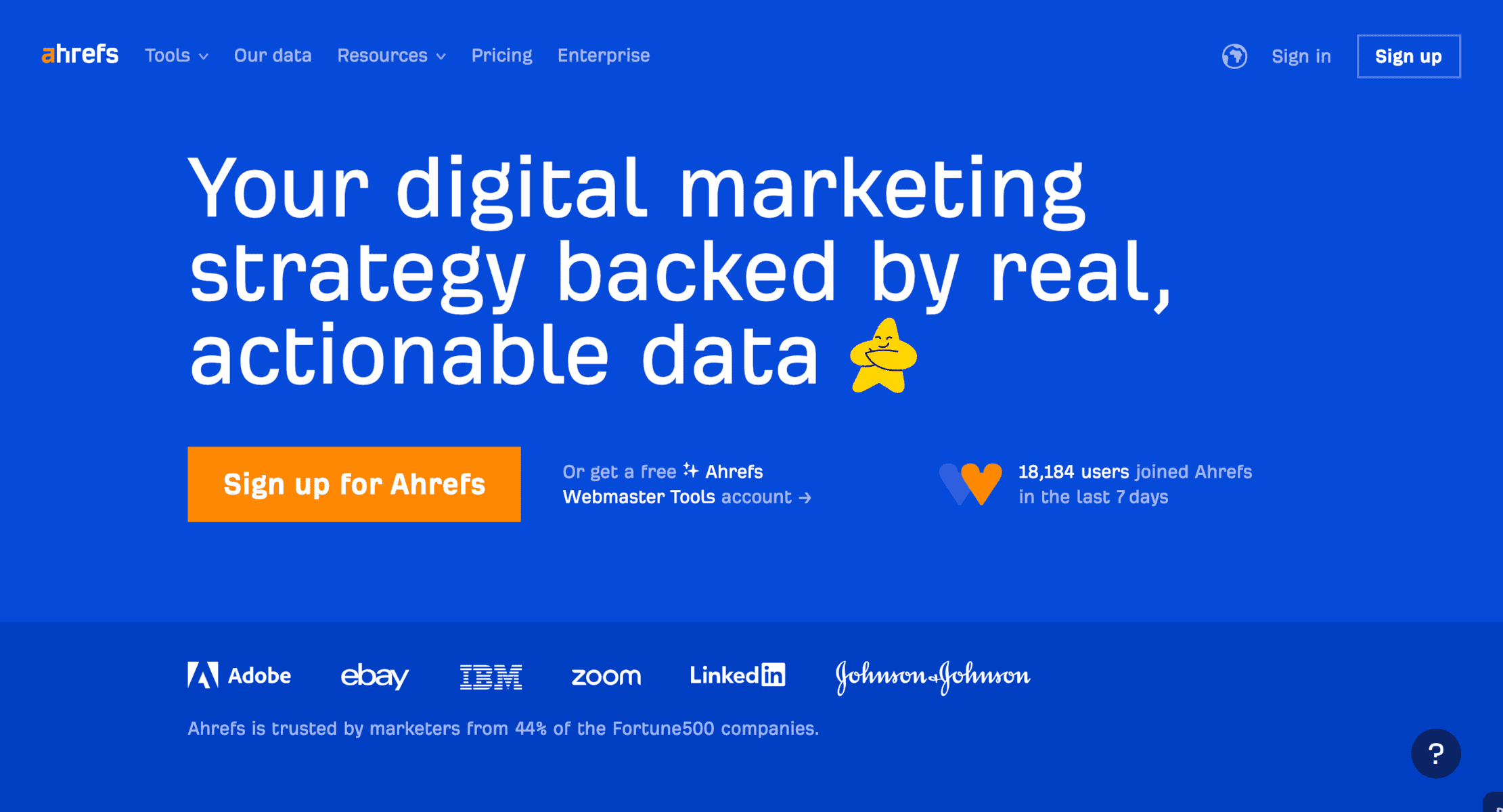
Ahrefs is another leading tool in the realm of SEO and competitor analysis, designed to help marketers refine their strategies by uncovering valuable data about search trends and content performance. Its powerful analytics make it indispensable for businesses focusing on improving organic visibility.
- Key Features:
- Backlink analysis and link-building opportunities.
- Keyword research with difficulty scoring.
- Content gap analysis to identify untapped opportunities.
- Rank tracking to monitor performance over time.
- Advantages:
- Provides deep insights into competitor SEO strategies.
- User-friendly interface for beginners and experts alike.
- Excellent for discovering high-value keywords and backlinks.
- Regularly updated with new features.
- Disadvantages:
- Higher cost compared to similar tools.
- Limited capabilities for paid ad analysis.
- Pricing: Starts at $129/month for basic plans, scaling with advanced features.
Google Trends – Tracking Market and Consumer Behavior

Google Trends offers a simple yet effective way to track what consumers are searching for online. It helps businesses understand seasonal demand, regional preferences, and emerging trends, making it a valuable addition to any market research toolkit.
- Key Features:
- Real-time tracking of search trends.
- Comparative keyword analysis across regions and timeframes.
- Insights into seasonal demand and interest spikes.
- Exportable data for further analysis.
- Advantages:
- Free to use with no subscription costs.
- Easy-to-use interface with clear visualizations.
- Ideal for identifying trends and regional preferences.
- Useful for planning campaigns around seasonal demand.
- Disadvantages:
- Limited depth compared to paid tools.
- Focused solely on Google search data.
- Pricing: Free.
AI Tools for Product Marketing
ChatGPT – Generative AI for Content and Messaging
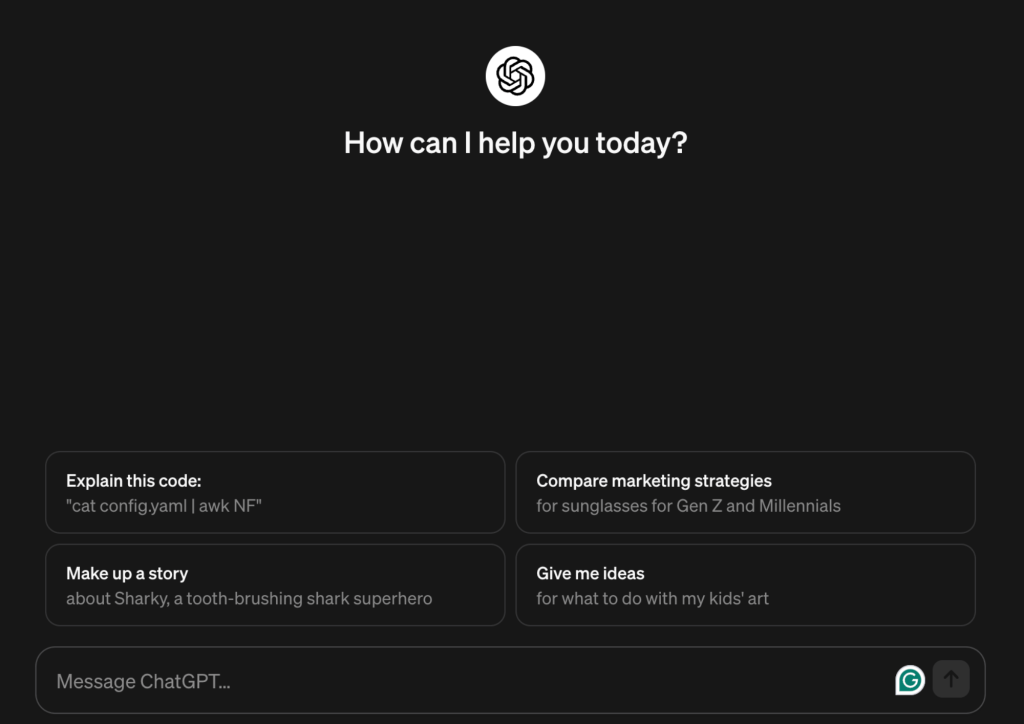
ChatGPT, powered by OpenAI, is a cutting-edge generative AI tool that assists marketers in creating compelling content, engaging customer messaging, and personalized campaigns. Its ability to process and generate human-like text makes it a game-changer for streamlining marketing workflows.
- Key Features:
- Generates high-quality content for blogs, emails, and social media.
- Provides quick responses for customer queries and support.
- Customizable tone and style to match brand guidelines.
- Supports brainstorming sessions with creative ideas and suggestions.
- Advantages:
- Saves time on content creation with AI-driven efficiency.
- Enhances personalization for customer communication.
- Accessible and easy to use, even for non-technical users.
- Continuously improves based on user feedback.
- Disadvantages:
- May require human editing to ensure accuracy and brand alignment.
- Limited knowledge of events or updates post-2021.
- Pricing: Free tier available; premium plans start at $20/month (ChatGPT Plus).
Jasper – AI-Powered Copywriting Tool
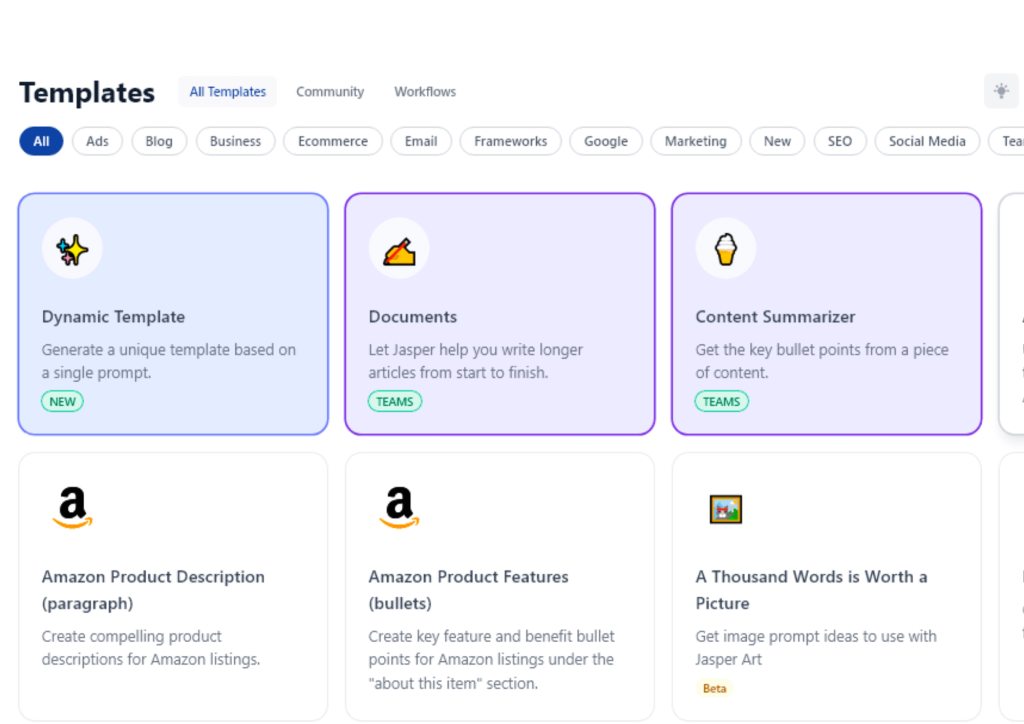
Jasper (formerly Jarvis) is an AI writing assistant specifically designed for marketers and content creators. It focuses on producing high-conversion copy, making it an essential tool for businesses looking to improve campaign performance.
- Key Features:
- Templates for emails, ad copy, and landing pages.
- AI-driven suggestions to enhance readability and engagement.
- Multilingual support for global campaigns.
- Integration with tools like Grammarly for content refinement.
- Advantages:
- Great for generating persuasive and SEO-friendly content.
- Reduces the time required for crafting marketing copy.
- User-friendly interface with customizable workflows.
- Supports collaboration among marketing teams.
- Disadvantages:
- Costs may be high for small teams or startups.
- Limited creative flexibility for highly unique content needs.
- Pricing: Plans start at $49/month, with scaling features for larger teams.
Kameleoon – AI for Conversion Rate Optimization
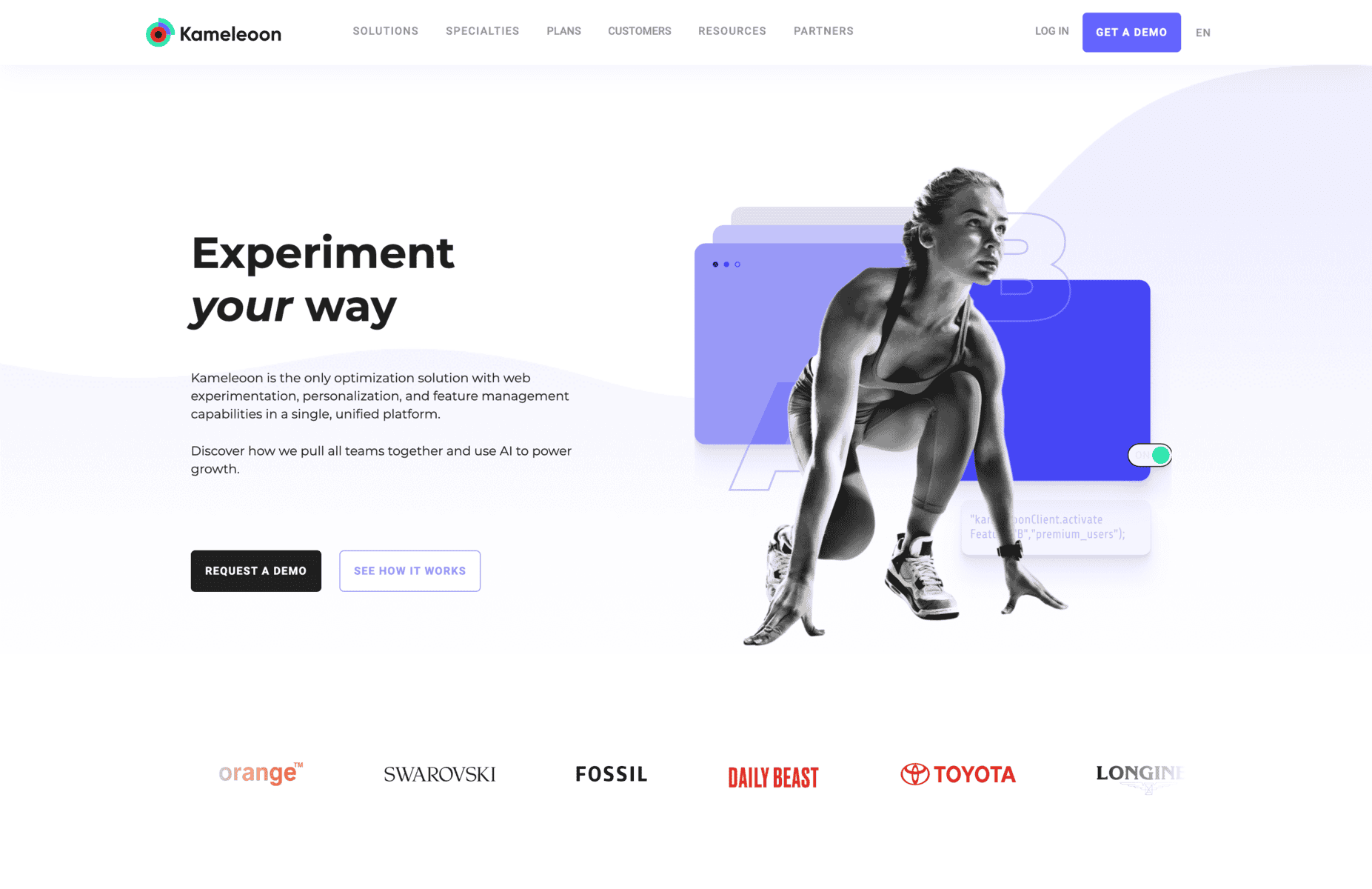
Kameleoon is a powerful AI platform that helps businesses optimize their websites and campaigns for conversions. By analyzing user behavior, it enables real-time personalization and A/B testing to improve engagement and sales.
- Key Features:
- AI-driven predictions for user intent.
- Real-time website personalization for specific audience segments.
- Advanced A/B testing tools with detailed analytics.
- Integration with popular marketing platforms like Google Analytics.
- Advantages:
- Improves conversion rates through data-backed personalization.
- Helps identify and target high-value customer segments.
- Enhances user experiences with AI-driven recommendations.
- Integrates easily with existing marketing ecosystems.
- Disadvantages:
- Pricing may be prohibitive for smaller businesses.
- Requires expertise to maximize its full potential.
Pricing: Custom pricing based on business size and needs.
Tools for User Behavior and Feedback
Hotjar – Heatmaps and Visitor Recordings
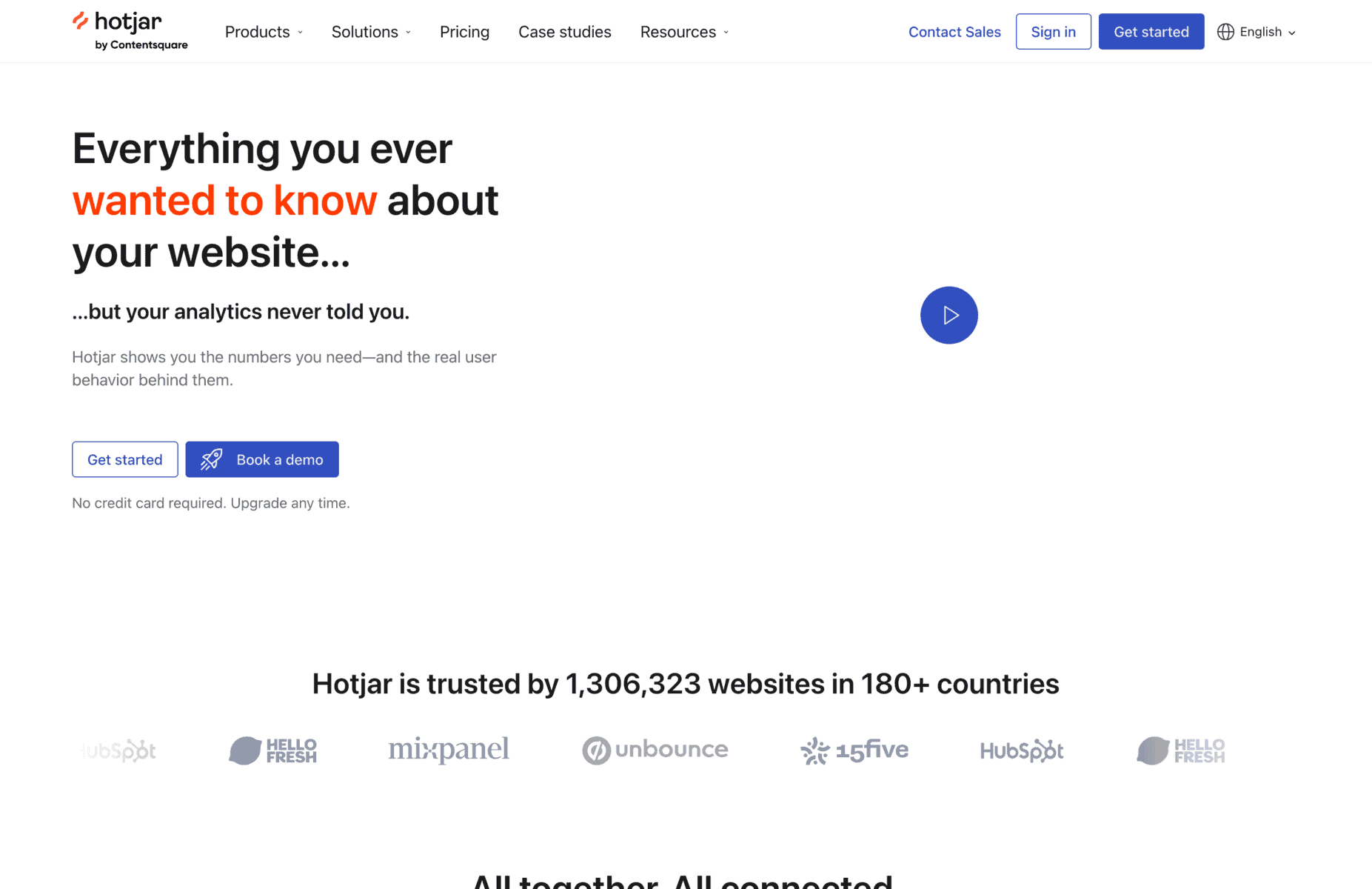
Hotjar is a user behavior analytics tool that helps businesses understand how visitors interact with their websites. By offering heatmaps and session recordings, it provides valuable insights into user behavior, enabling marketers to optimize their websites for better engagement.
- Key Features:
- Heatmaps to visualize clicks, scrolls, and mouse movements.
- Session recordings to observe user journeys.
- Feedback widgets for collecting user opinions directly.
- Funnel tracking to identify drop-off points in conversion paths.
- Advantages:
- Easy to use with a clear and intuitive interface.
- Provides actionable data for improving website design and content.
- Enables businesses to understand user pain points.
- Affordable for small and medium-sized businesses.
- Disadvantages:
- Limited features in the free version.
- Requires integration with other tools for advanced analytics.
- Pricing: Free basic plan; paid plans start at $39/month.
UserTesting – Customer Feedback for Better Campaigns
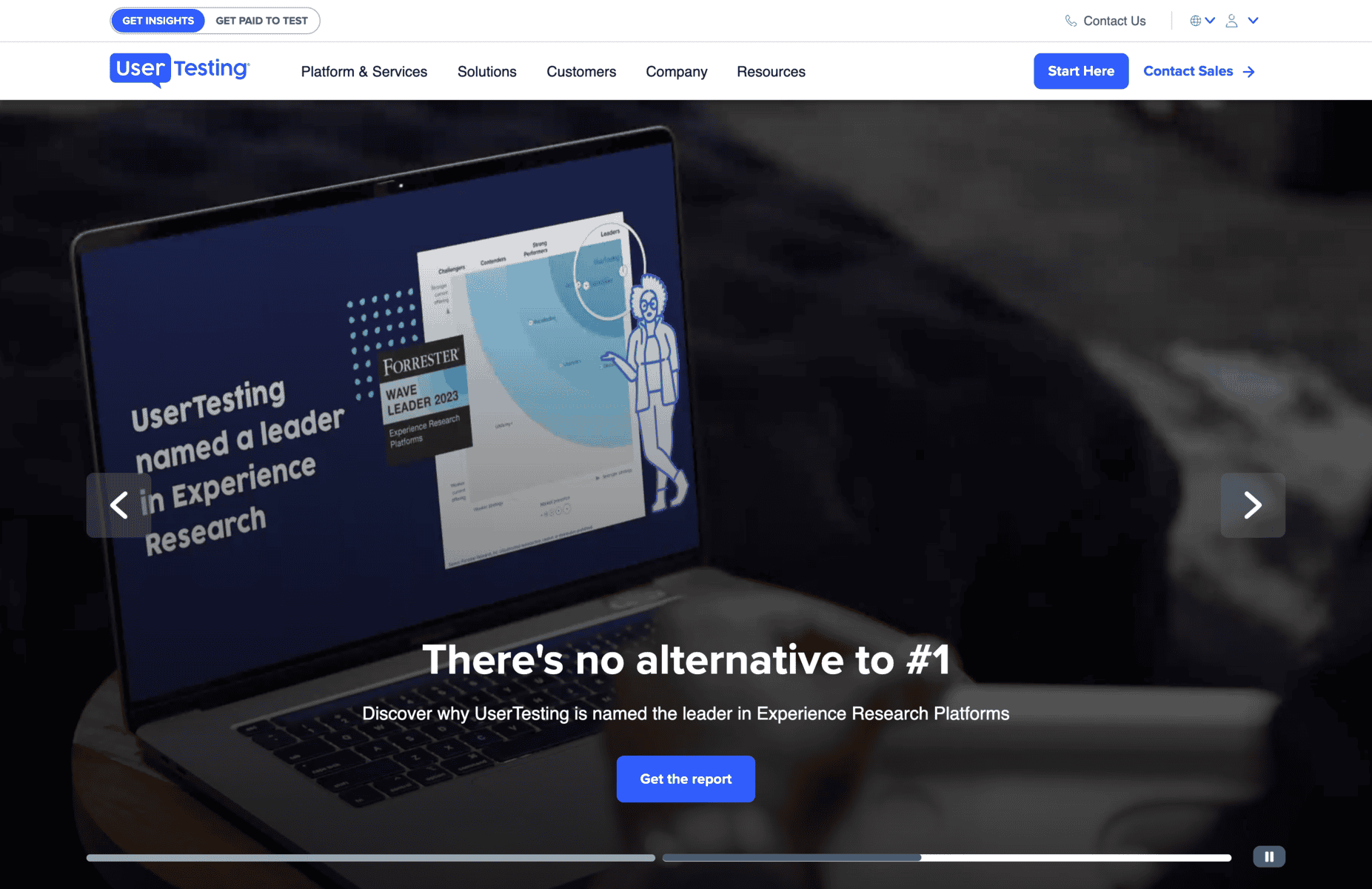
UserTesting enables businesses to gather detailed feedback from real users by allowing them to test websites, apps, or prototypes. It delivers valuable qualitative insights that help refine product marketing strategies and user experiences.
- Key Features:
- Video feedback from real users interacting with your product.
- Targeted participant selection for specific demographics.
- Insightful reports summarizing key findings.
- Templates for creating tests and surveys.
- Advantages:
- Provides direct insights from real customers.
- Ideal for identifying usability issues and improving design.
- Allows businesses to refine campaigns based on user preferences.
- Flexible testing options for various digital assets.
- Disadvantages:
- Pricing can be steep for small teams.
- Analysis requires time and expertise to derive actionable insights.
- Pricing: Plans start at $49 per video session, with custom enterprise options available.
Segment – Customer Data Management and Insights
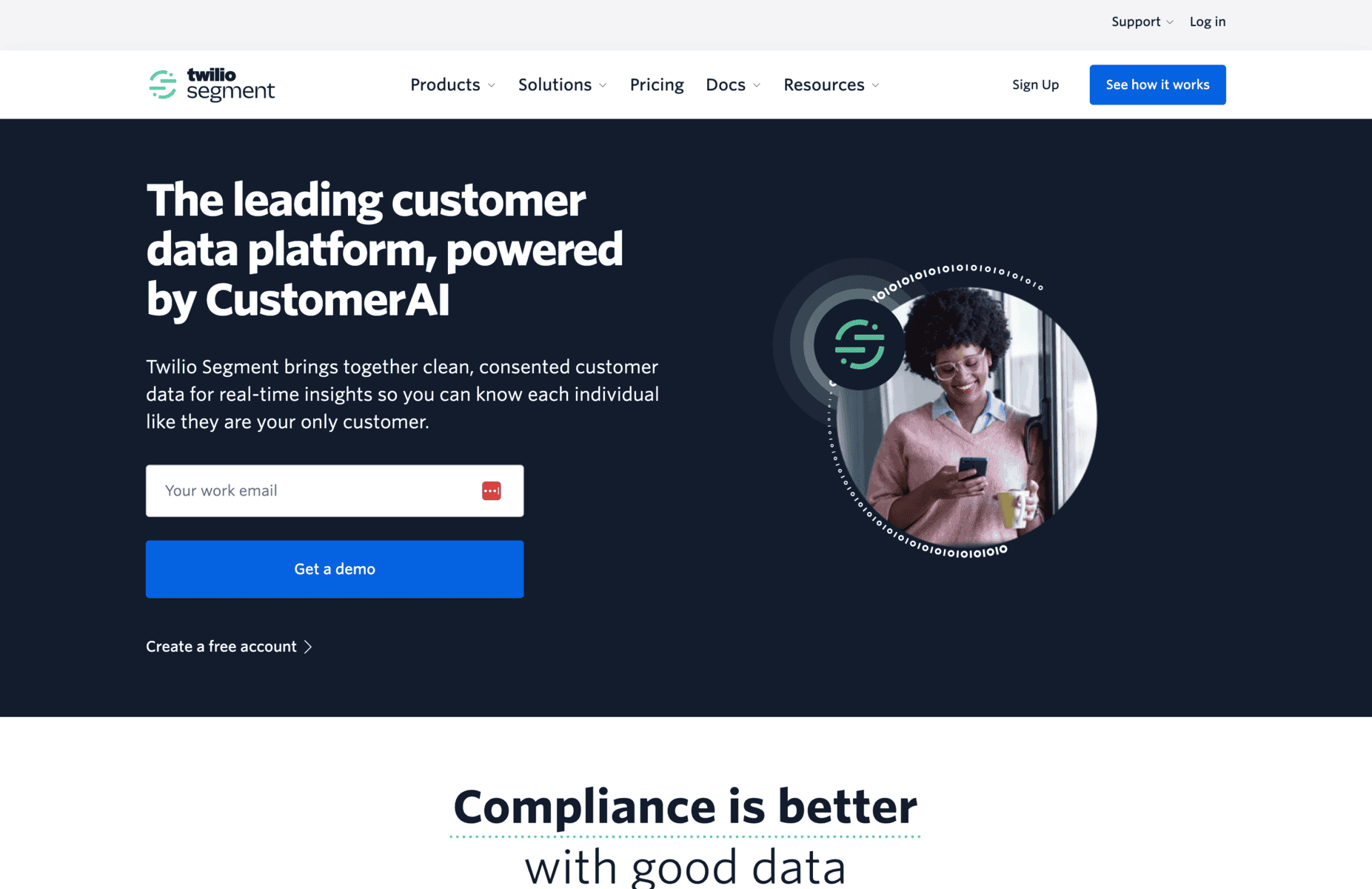
Segment is a customer data platform that helps businesses collect, unify, and analyze data from multiple sources. It enables marketers to create a complete picture of their audience and make data-driven decisions to improve product marketing campaigns.
- Key Features:
- Centralized platform for customer data aggregation.
- Integration with over 300 tools for analytics and marketing.
- Real-time data updates for actionable insights.
- Identity resolution to unify data across devices and platforms.
- Advantages:
- Simplifies data management across multiple tools.
- Improves personalization through detailed customer profiles.
- Helps identify key trends and audience segments.
- Reduces redundancy by integrating existing tools seamlessly.
- Disadvantages:
- Setup and configuration can be complex for new users.
- High costs for premium features and large-scale data needs.
- Pricing: Free for basic features; paid plans start at $120/month.
Heap Analytics – Journey Tracking and Habit Insights
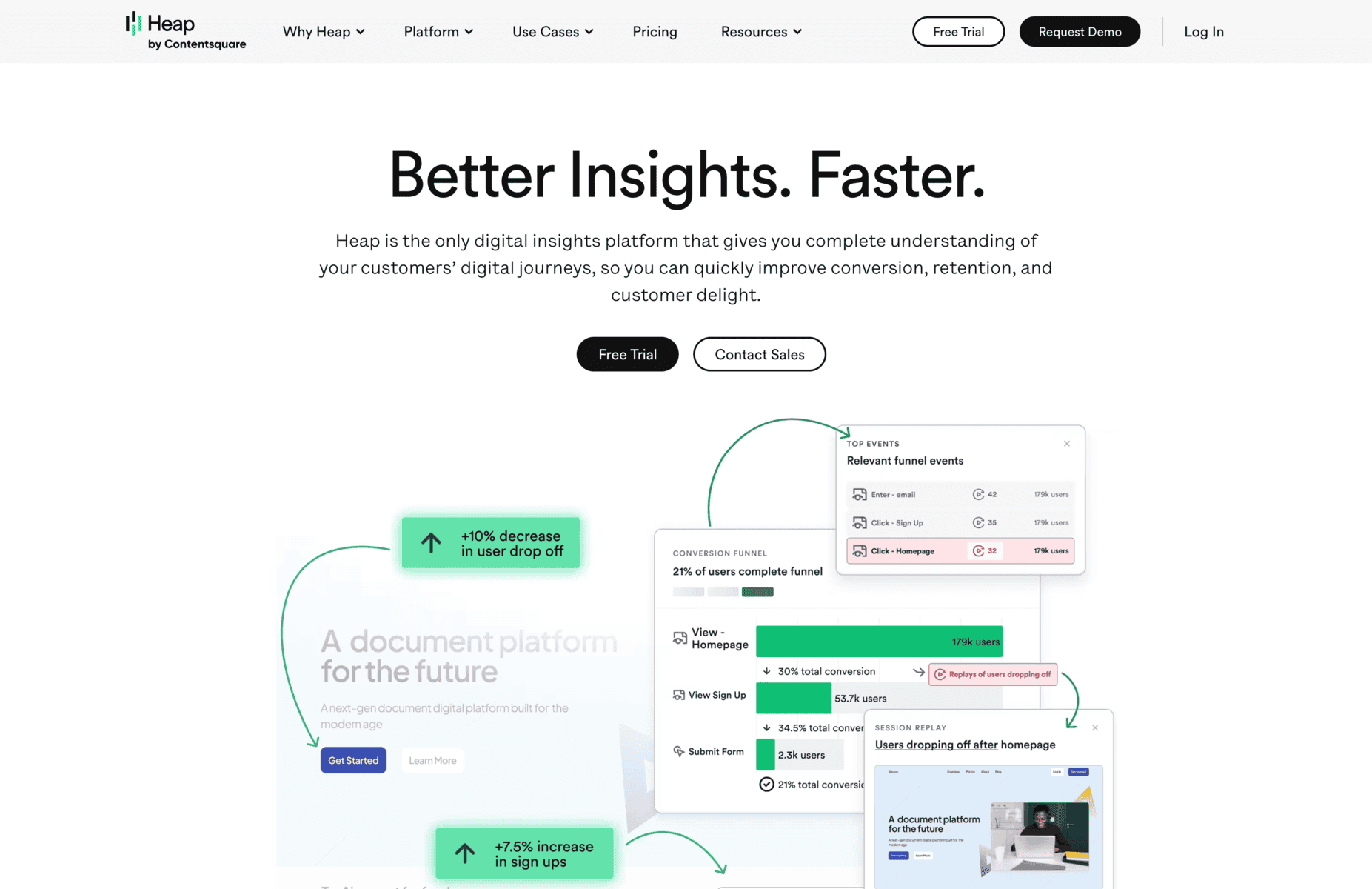
Heap Analytics focuses on helping businesses understand customer journeys by automatically capturing user interactions. This allows for detailed behavioral analysis without requiring extensive manual tracking.
- Key Features:
- Automatic data capture for all user interactions.
- Funnel analysis to identify drop-off points.
- User segmentation based on behaviors and demographics.
- Custom dashboards for visualizing key metrics.
- Advantages:
- Reduces the effort of manual event tracking.
- Provides in-depth insights into user habits and preferences.
- Easy-to-use interface with customizable analytics.
- Helps optimize conversion funnels with actionable data.
- Disadvantages:
- Requires time to configure and interpret complex data.
- Pricing may not suit small-scale businesses.
- Pricing: Free plan available for startups; paid plans start at $3,600/year.
Collaboration and Project Management Tools for Teams
Slack – Seamless Team Communication
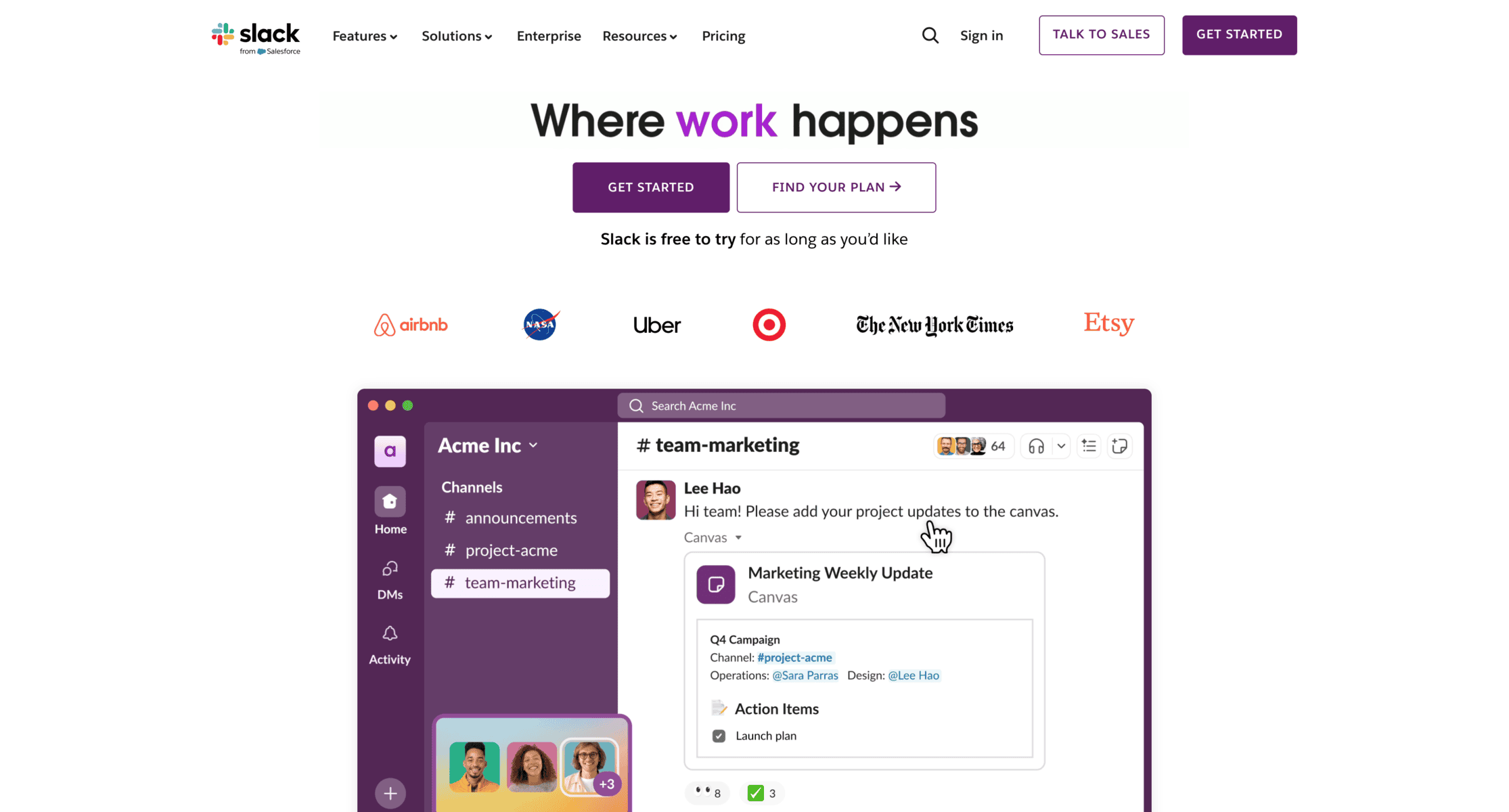
Slack is one of the most popular tools for team communication, allowing marketing teams to collaborate in real-time. Its channels and integrations streamline workflows and ensure everyone stays aligned.
- Key Features:
- Organized channels for team and project-specific discussions.
- Integration with tools like Google Drive, Trello, and Zoom.
- File sharing and searchable message history.
- Video and voice call options for direct communication.
- Advantages:
- Encourages efficient, real-time team communication.
- Reduces email clutter with streamlined discussions.
- Highly customizable with numerous app integrations.
- Accessible on desktop and mobile devices.
- Disadvantages:
- Can become overwhelming with excessive notifications.
- Free plan limits searchable message history and integrations.
Pricing: Free basic plan; paid plans start at $7.25/user/month.
Monday.com – Project Management for Marketing Teams
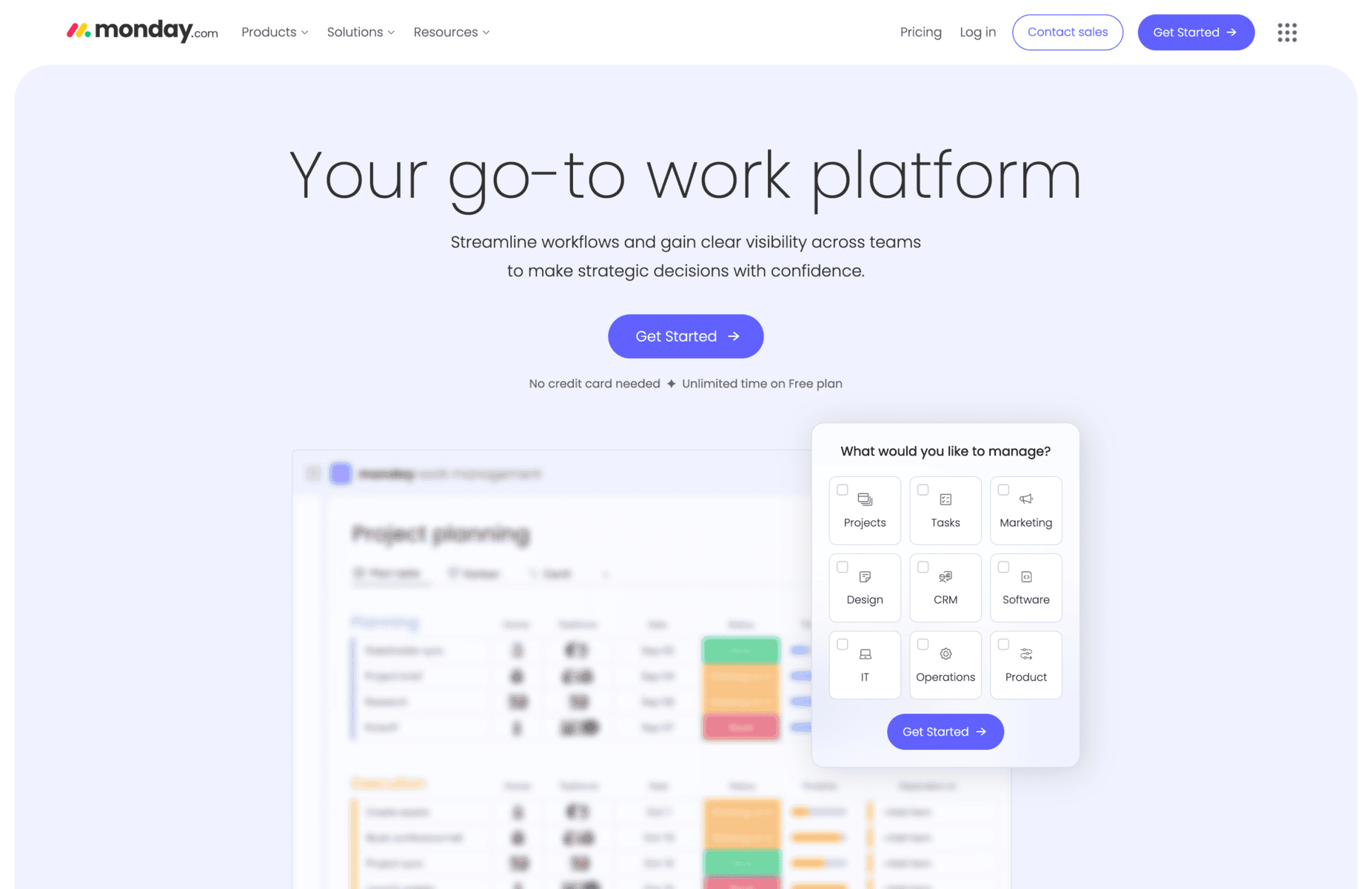
Managing marketing projects efficiently is critical, and Monday.com provides a powerful platform for organizing tasks and improving collaboration. With its visual workflow system, it’s particularly useful for marketing teams juggling multiple campaigns simultaneously.
- Key Features:
- Customizable visual boards to track project progress.
- Seamless integration with tools like Mailchimp, HubSpot, and Google Workspace.
- Pre-designed templates for marketing workflows.
- Real-time collaboration with updates and notifications.
- Advantages:
- Simplifies complex project tracking with visual workflows.
- Highly customizable to fit different marketing needs.
- Enhances team communication and accountability.
- Disadvantages:
- Costs can add up for larger teams or premium features.
- Learning curve for teams new to workflow-based tools.
- Pricing: Plans start at €9/seat/month, with higher tiers offering advanced automation and analytics.
Process Street – Workflow Automation for Marketers
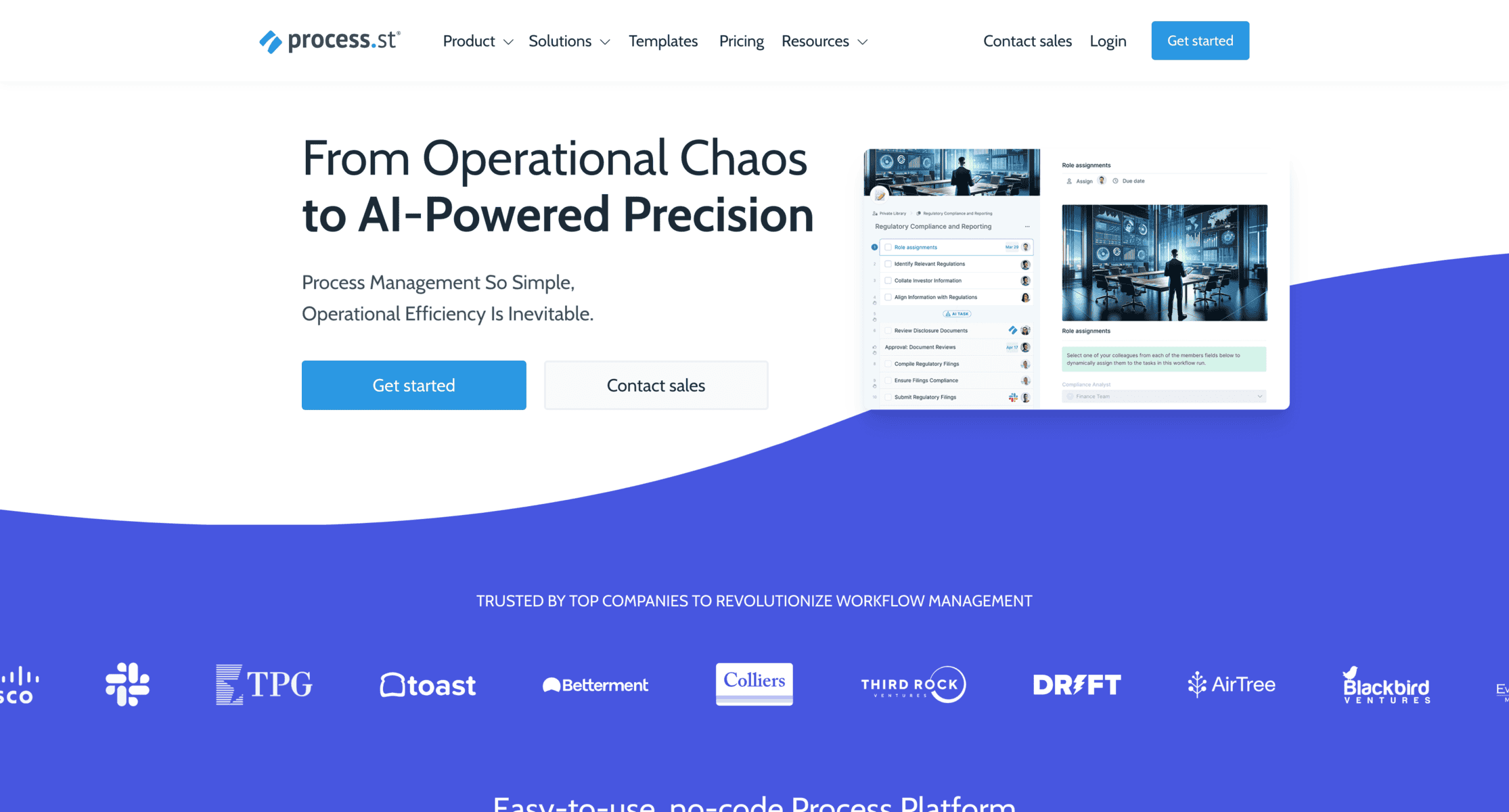
Process Street helps marketers streamline recurring tasks with its workflow automation capabilities. It’s a valuable tool for teams looking to enhance productivity and maintain consistency in campaign execution.
- Key Features:
- Customizable workflows for repetitive tasks.
- Collaborative checklists for team projects.
- Integration with over 2,000 apps via Zapier.
- Detailed activity tracking for accountability.
- Advantages:
- Simplifies repetitive tasks with automation.
- Enhances team productivity with clear workflows.
- Scalable for small and large teams alike.
- Reduces errors in repetitive marketing activities.
- Disadvantages:
- Requires time to set up workflows initially.
- Advanced features are locked behind higher pricing tiers.
Pricing: Free for individuals; paid plans start at $25/user/month.
Trello – Visual Task and Workflow Management
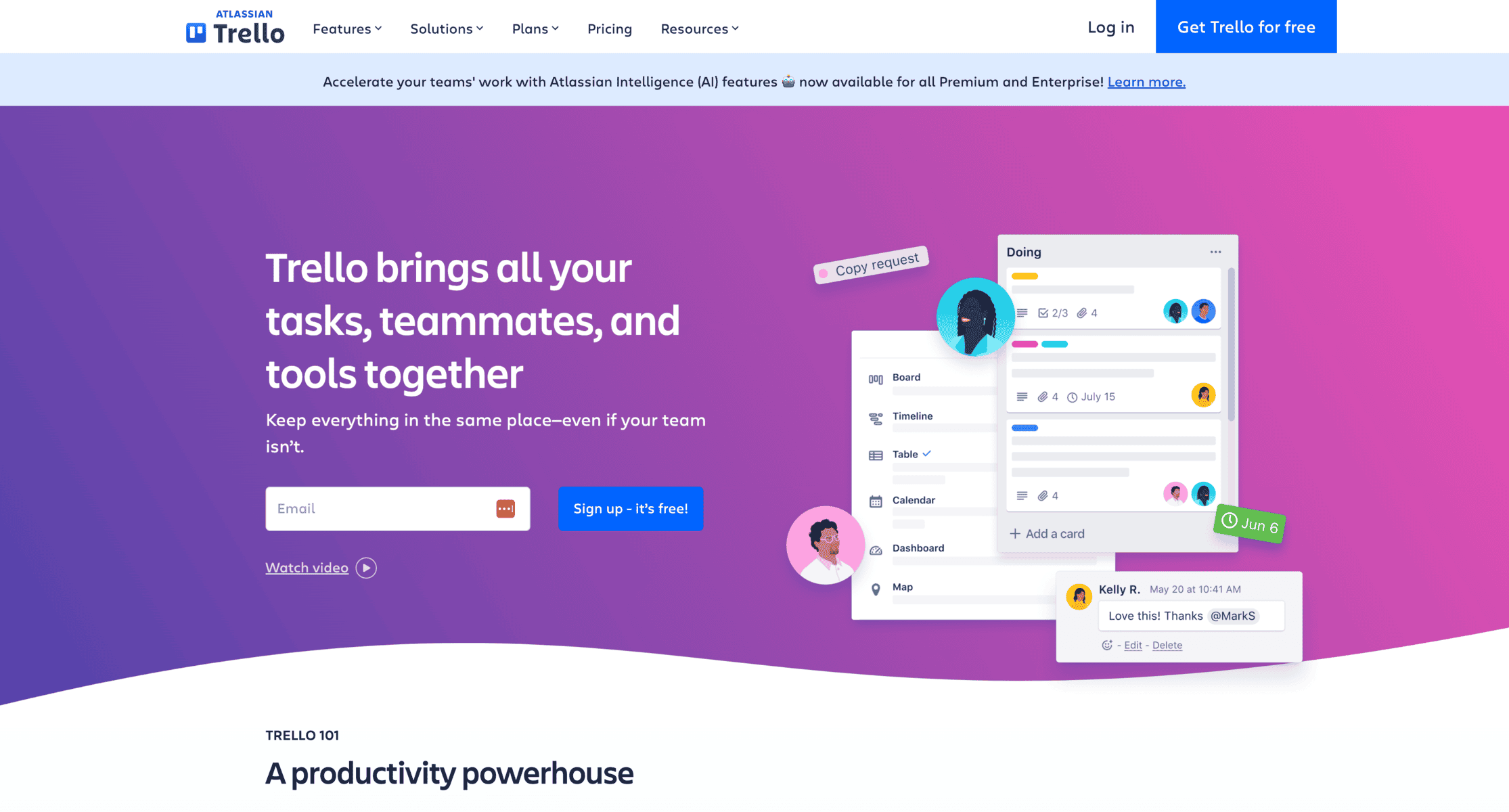
Trello offers a simple and visual way to manage projects through its card-and-board system. It’s particularly effective for marketing teams needing to track progress and collaborate on tasks.
- Key Features:
- Drag-and-drop boards for task organization.
- Pre-built templates for marketing workflows.
- Integration with popular tools like Slack and Google Drive.
- Checklists, due dates, and labels for detailed task management.
- Advantages:
- Intuitive and easy for beginners to use.
- Highly visual, making it ideal for project tracking.
- Offers free basic functionality for smaller teams.
- Encourages collaboration through shared boards.
- Disadvantages:
- Lacks advanced features like time tracking or analytics.
- Can become cluttered for complex projects without clear organization.
Pricing: Free for basic features; paid plans start at $5/user/month.
Asana – Task Management for Marketing Teams
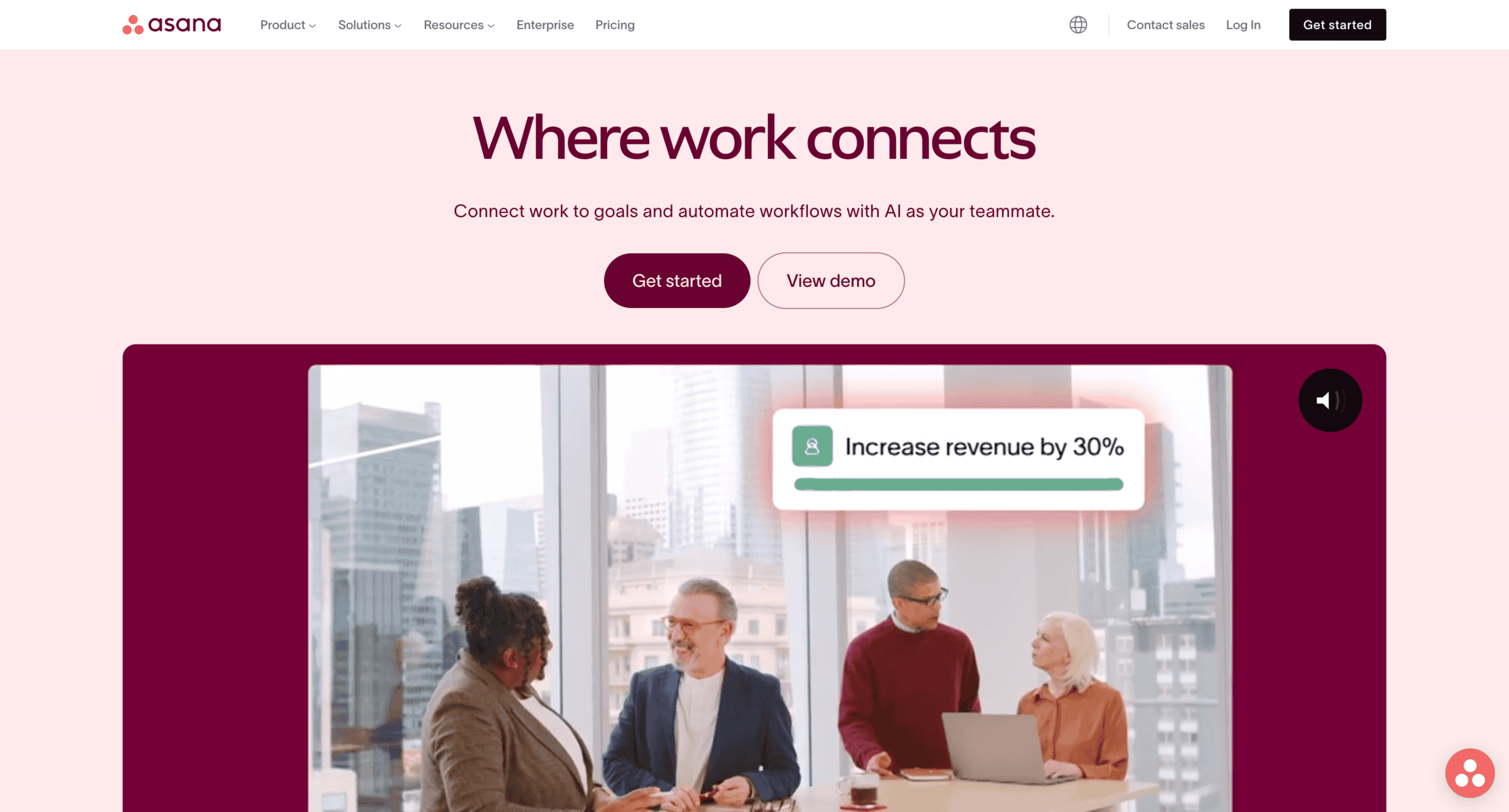
Asana is a powerful project management tool designed to help teams organize tasks, track progress, and meet deadlines. Its versatility makes it a favorite among marketing teams for managing campaigns and content calendars.
- Key Features:
- Task assignment and progress tracking.
- Pre-built templates for marketing campaigns and content plans.
- Integration with Slack, Google Drive, and Adobe Creative Cloud.
- Visual project timelines and calendar views.
- Advantages:
- Encourages team accountability with task assignments.
- Flexible customization for different project types.
- Offers detailed analytics to measure project performance.
- Simplifies coordination for large teams.
- Disadvantages:
- Premium features can be expensive for small teams.
- May feel complex for first-time users.
Pricing: Free for basic features; paid plans start at $10.99/user/month.
Creativity and Content Curation Tools
Canva – Design Tool for Marketing Materials
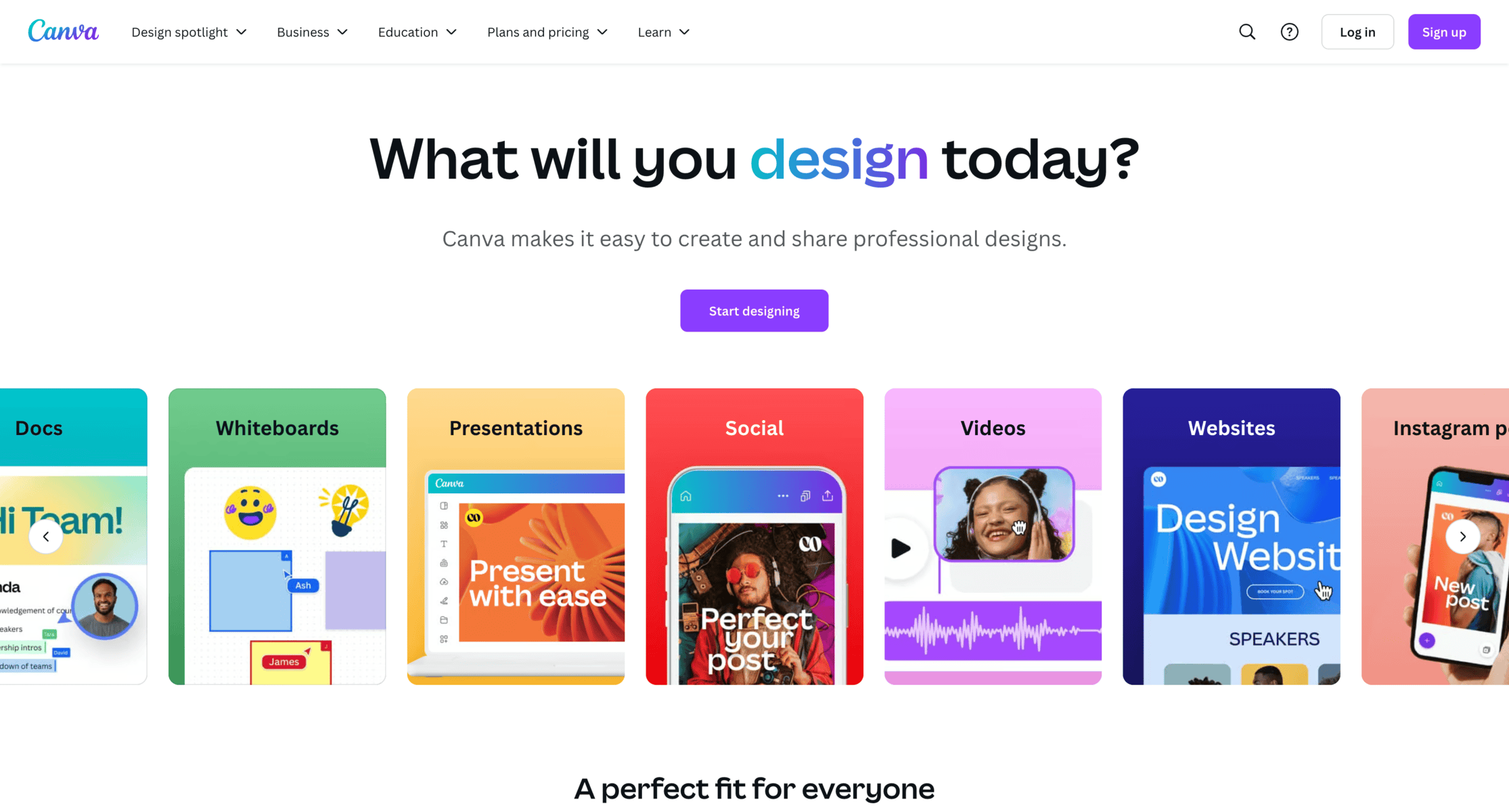
Canva is an intuitive design platform that enables marketers to create professional-quality graphics, social media posts, and presentations. It’s a favorite for teams with or without design expertise.
- Key Features:
- Drag-and-drop interface with thousands of templates.
- Extensive library of images, icons, and fonts.
- Collaboration tools for team projects.
- Customizable brand kits to maintain consistent branding.
- Advantages:
- Easy to use for beginners and non-designers.
- Affordable compared to professional design tools.
- Great for quick, high-quality visuals.
- Supports real-time collaboration.
- Disadvantages:
- Limited functionality for advanced design needs.
- Some premium assets require additional fees.
Pricing: Free for basic use; Pro plans start at $12.99/month.
Wistia – Video Marketing for Customer Engagement
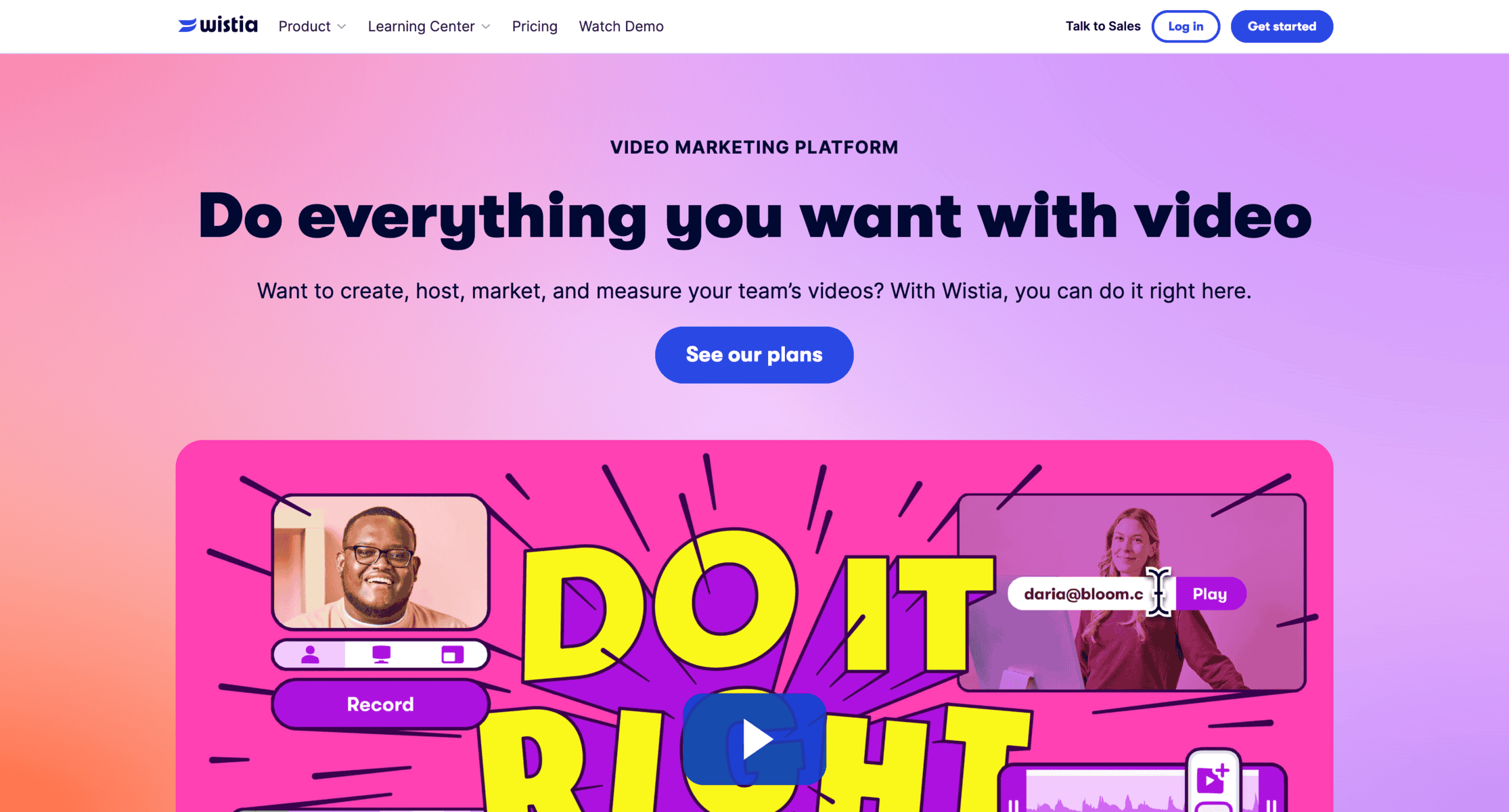
Wistia specializes in video hosting and analytics, making it ideal for marketers aiming to boost customer engagement through video content. It focuses on providing tools tailored for business and brand storytelling.
- Key Features:
- High-quality video hosting with branding options.
- Advanced analytics to track viewer engagement.
- Integration with marketing tools like HubSpot and Mailchimp.
- Customizable calls-to-action (CTAs) and email capture features.
- Advantages:
- Helps create professional, branded video experiences.
- Provides actionable data to optimize video content.
- Integrates seamlessly with email and CRM tools.
- Supports growth through video-driven lead generation.
- Disadvantages:
- Limited to video-focused marketing strategies.
- Pricing may be steep for small businesses.
- Pricing: Free for up to 3 videos; Pro plans start at $19/month.
BuzzSumo – Research Trending Topics and Content Ideas
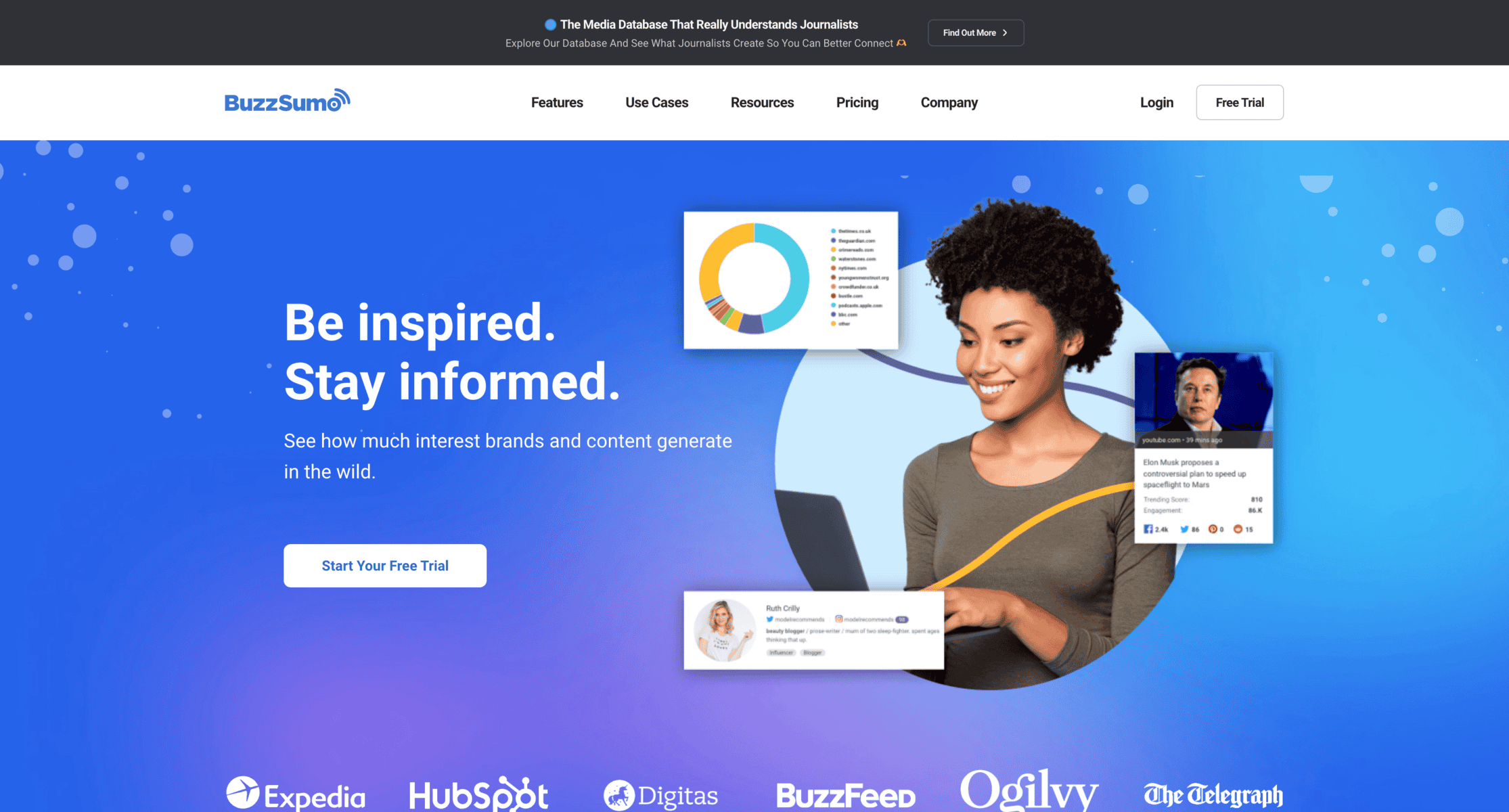
BuzzSumo is a content research tool that helps marketers discover trending topics and understand what resonates with their audience. It’s essential for planning effective content strategies.
- Key Features:
- Insights into trending topics and popular content.
- Competitor content analysis for benchmarking.
- Social media share tracking.
- Alerts for brand mentions and keywords.
- Advantages:
- Ideal for identifying content that drives engagement.
- Simplifies competitive analysis in content marketing.
- Helps refine social media and blog strategies.
- User-friendly interface with clear metrics.
- Disadvantages:
- Limited features in the free version.
- Advanced analytics require a premium subscription.
- Pricing: Free for basic searches; paid plans start at $99/month.
Typeform – Interactive Surveys and Feedback
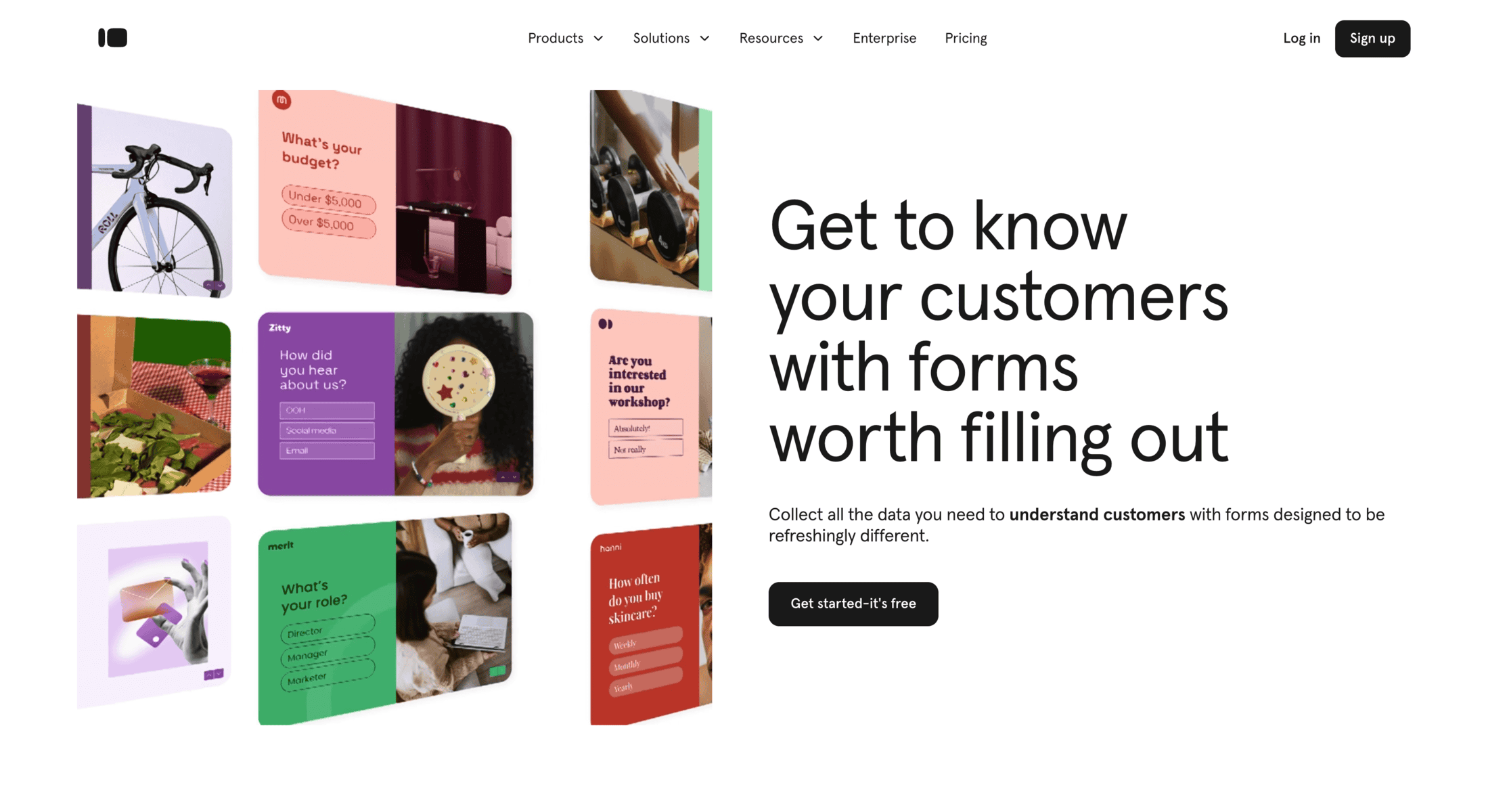
Typeform is a tool that allows marketers to create interactive surveys and forms, making it easy to collect customer feedback while maintaining an engaging user experience.
- Key Features:
- Customizable, visually appealing survey templates.
- Logic branching for personalized questions.
- Integration with tools like Slack and Google Sheets.
- Analytics to track survey performance and responses.
- Key Features:
- Advantages:
- Enhances engagement with conversational surveys.
- Simplifies feedback collection with intuitive design.
- Supports real-time data tracking and analysis.
- Works well for lead generation and market research.
- Disadvantages:
- Limited questions and responses on the free plan.
- Premium plans can be expensive for small businesses.
- Pricing: Free basic plan; paid plans start at $29/month.
Marketing Automation and Customer Engagement Tools
Intercom – Chatbot and Customer Engagement Platform
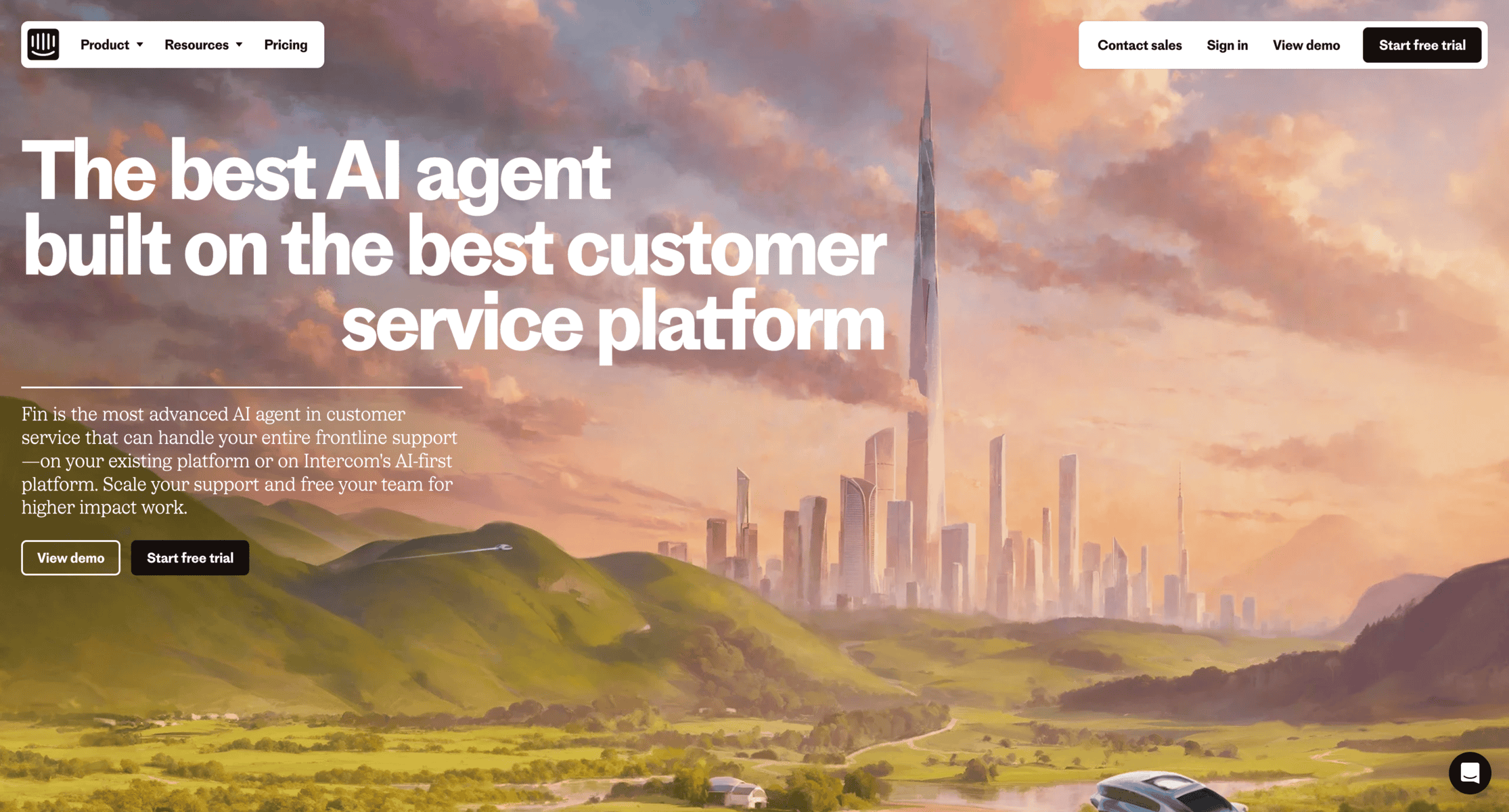
Intercom is a customer communication tool that uses automation to engage users through chatbots, targeted messaging, and live chat. It’s designed to help businesses build stronger relationships with their customers.
- Key Features:
- AI-powered chatbots for instant customer support.
- Real-time messaging and ticket management.
- Targeted email and in-app messaging.
- Integration with CRM and marketing tools.
- Advantages:
- Enhances customer engagement with personalized interactions.
- Reduces response times with automation.
- Scales easily for businesses of all sizes.
- Provides analytics to measure campaign success.
- Disadvantages:
- Pricing can escalate for larger teams.
- May require technical setup for advanced features.
- Pricing: Plans start at $74/month, with add-ons for advanced functionality.
HubSpot – All-in-One Marketing and Sales Platform
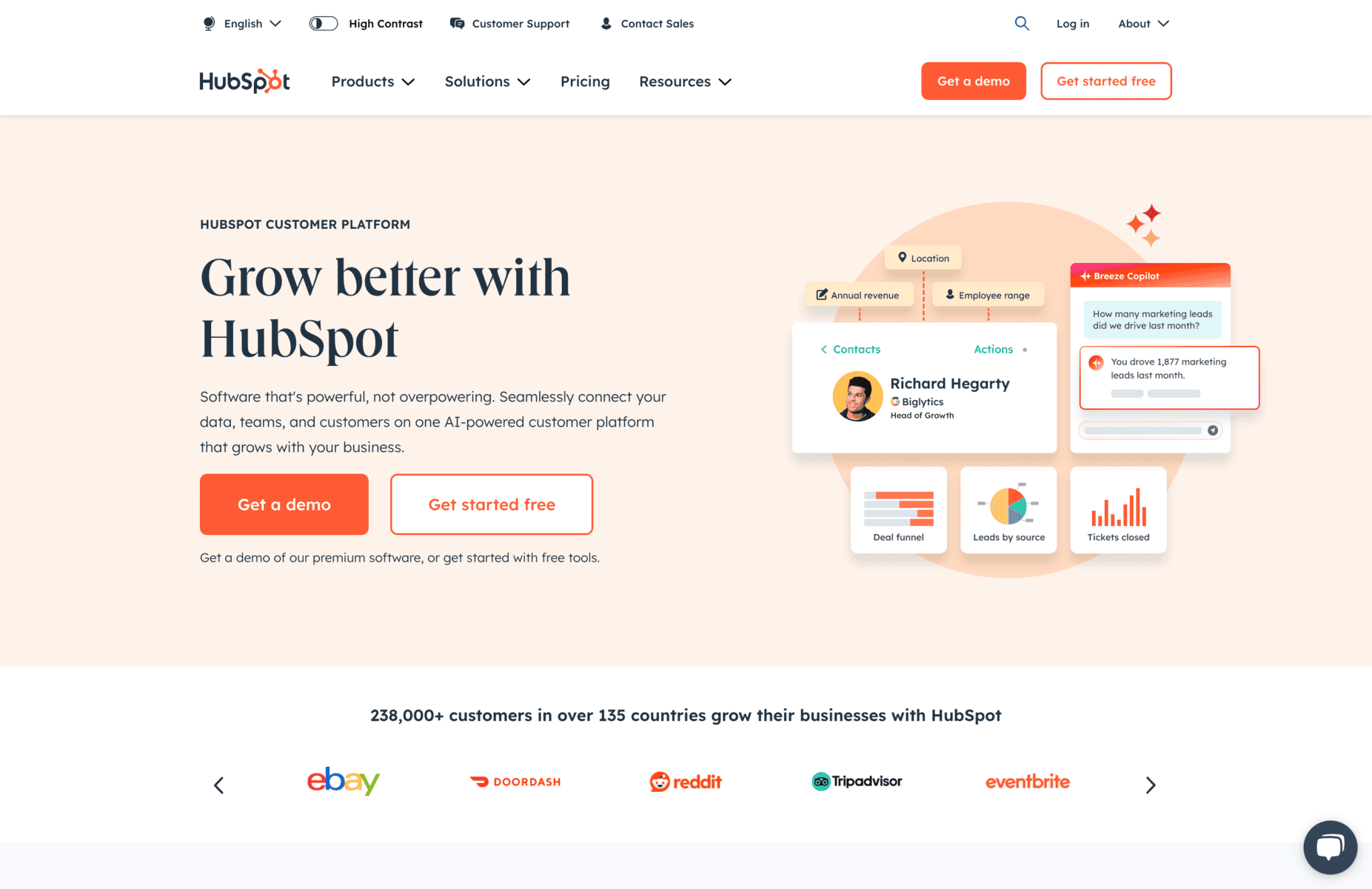
HubSpot stands out as one of the most comprehensive product marketing tools, offering features that span inbound marketing, customer relationship management (CRM), and sales. It’s particularly effective for teams looking to manage campaigns, nurture leads, and analyze results in one place.
- Key Features:
- Email marketing with automation workflows.
- Integrated CRM for seamless tracking of customer interactions.
- Tools for creating landing pages, blogs, and social media posts.
- Advanced analytics and reporting for performance insights.
- Advantages:
- Combines multiple marketing functionalities into a single platform.
- Provides free tools ideal for startups and small businesses.
- Regular updates and extensive resources for learning and support.
- Disadvantages:
- Premium features can be expensive for small teams.
- Advanced tools may have a steep learning curve.
Pricing: Free for basic features; paid plans start at $20/seat/month, scaling with additional functionality.
Indigitall – AI-Powered Customer Engagement Across Every Channel
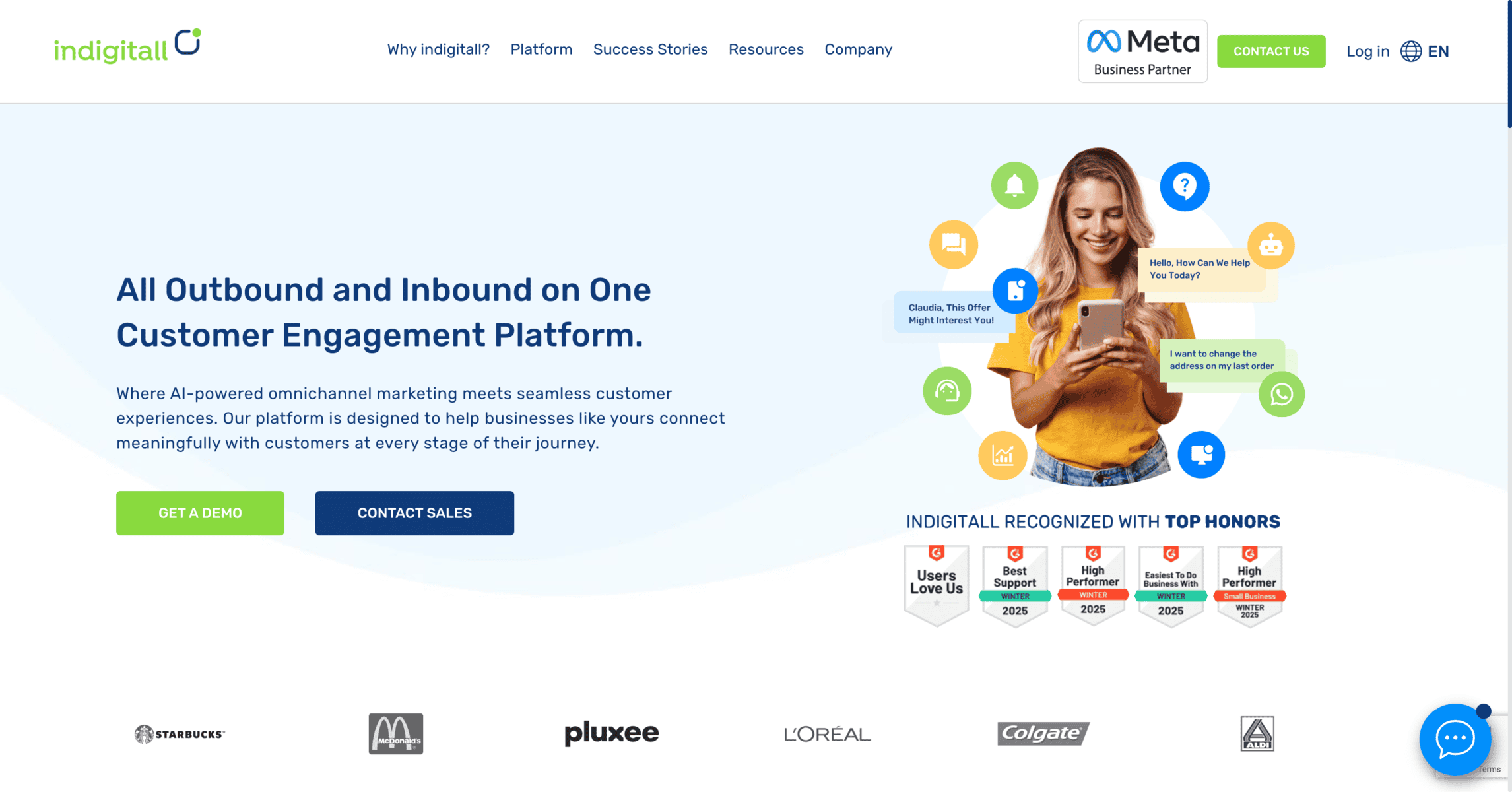
Customer engagement is no longer about just one or two channels—it’s about seamless, personalized interactions across multiple touchpoints.
That’s where indigitall comes in. This AI-powered marketing automation platform enables businesses to orchestrate customer journeys, automate messaging, and optimize engagement across push notifications, email, SMS, chatbots, and more. If you’re looking for a solution to centralize your digital communication strategy, indigitall is worth considering.
Why indigitall Stands Out
- Omnichannel Messaging – Reach users via push notifications, email, SMS, WhatsApp, Facebook Messenger, and in-app messaging.
- AI-Powered Personalization – Leverage artificial intelligence to tailor content, predict user behavior, and automate customer journeys.
- Real-Time Customer Insights – Track user interactions across channels to refine targeting and improve engagement.
- Seamless Integrations – Works with CRMs, analytics tools, and marketing automation platforms for a unified experience.
Potential Drawbacks
- AI Learning Curve – While automation is powerful, getting the most out of AI-driven personalization may require fine-tuning.
- Best for Digital-First Brands – Ideal for businesses with a strong online presence but may be overkill for brands with limited digital engagement.
💰 Pricing: Custom pricing based on business needs.
ActiveCampaign – Email Marketing and Automation
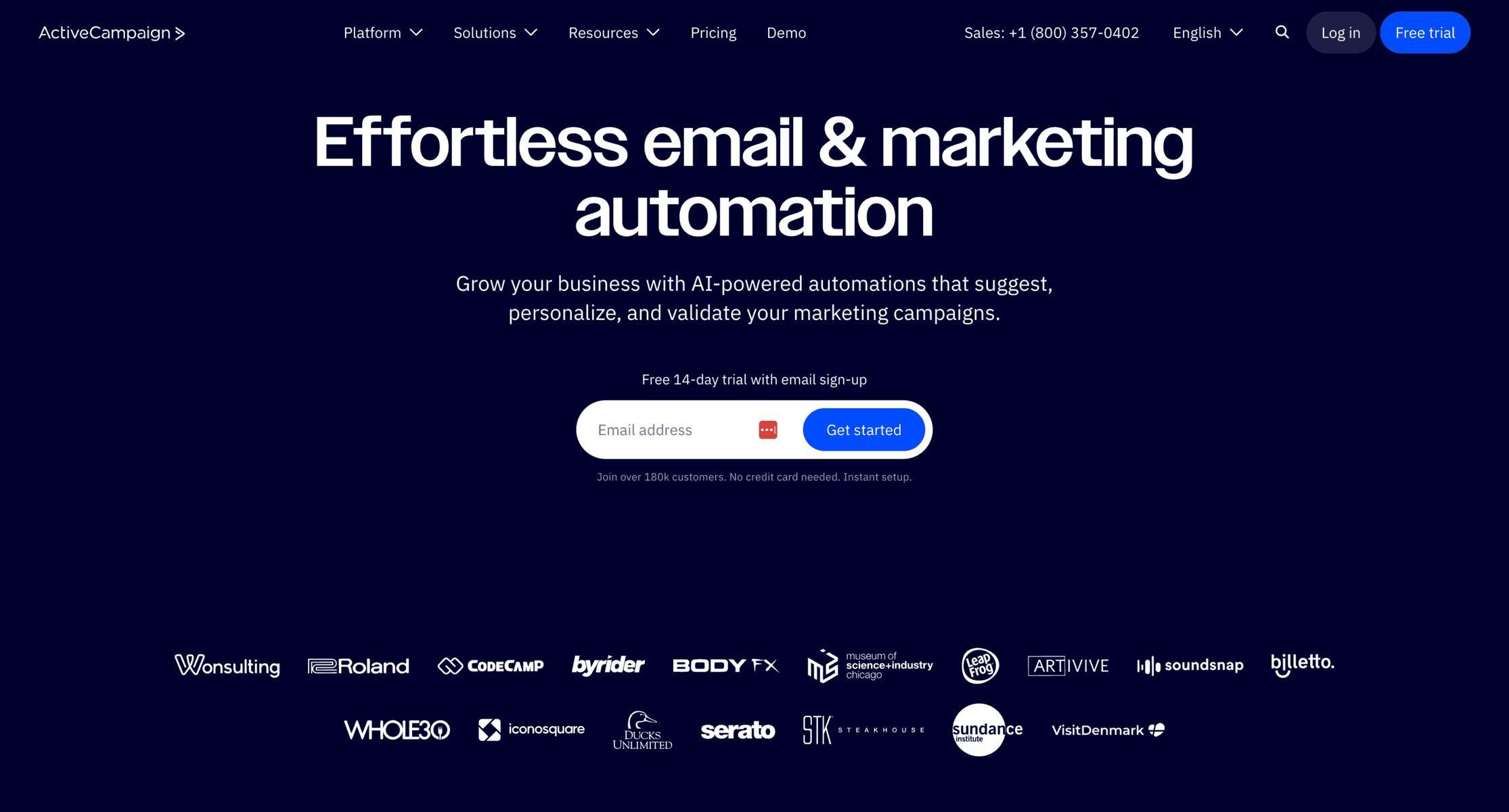
ActiveCampaign is a marketing automation platform known for its email marketing capabilities. It helps businesses streamline their communication, nurture leads, and improve customer retention.
- Key Features:
- Email automation workflows with advanced triggers.
- Segmentation tools for personalized campaigns.
- CRM integration for lead tracking.
- Built-in A/B testing for optimizing email performance.
- Advantages:
- Offers robust automation features for email marketing.
- Great for creating personalized customer journeys.
- User-friendly interface with detailed reporting.
- Affordable for small businesses and startups.
- Disadvantages:
- Limited functionality outside of email-focused automation.
- Advanced workflows may require a learning curve.
Pricing: Plans start at $29/month, scaling with additional contacts and features.
Buffer – Social Media Scheduling and Analysis
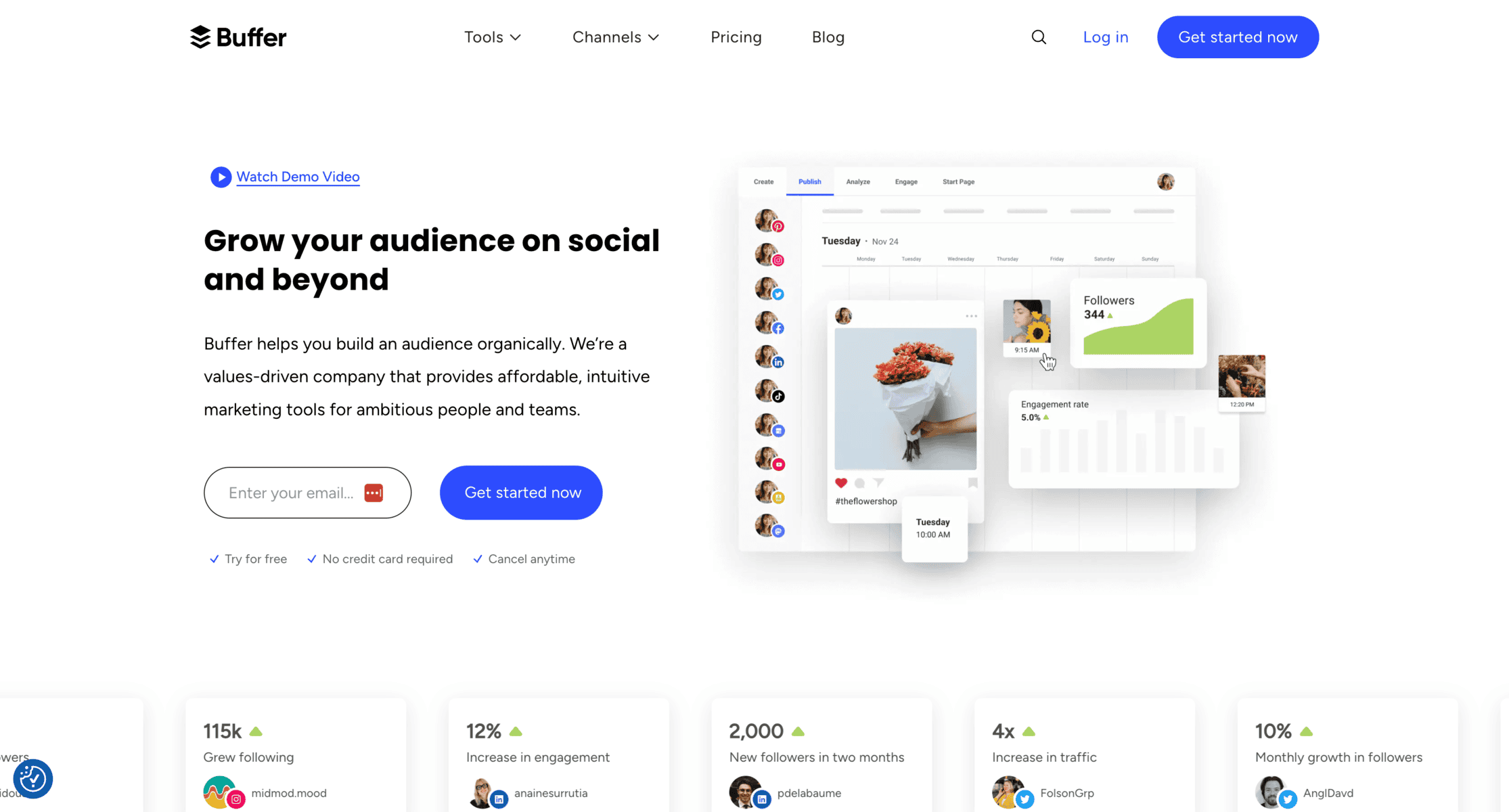
Buffer is a social media management tool that simplifies scheduling, posting, and analyzing performance across multiple platforms. It’s ideal for marketers looking to maintain a consistent online presence.
- Key Features:
- Scheduling and publishing for all major social platforms.
- Analytics to measure engagement and reach.
- Content calendar for streamlined planning.
- Team collaboration features for social campaigns.
- Advantages:
- Simplifies social media management with an intuitive interface.
- Helps marketers maintain consistent posting schedules.
- Provides insights to refine social media strategies.
- Affordable for small businesses.
- Disadvantages:
- Limited analytics in the basic plans.
- Advanced features, like engagement tracking, require premium plans.
- Pricing: Free basic plan; paid plans start at $6/month per social channel.
Drift – Conversational Marketing and Lead Generation
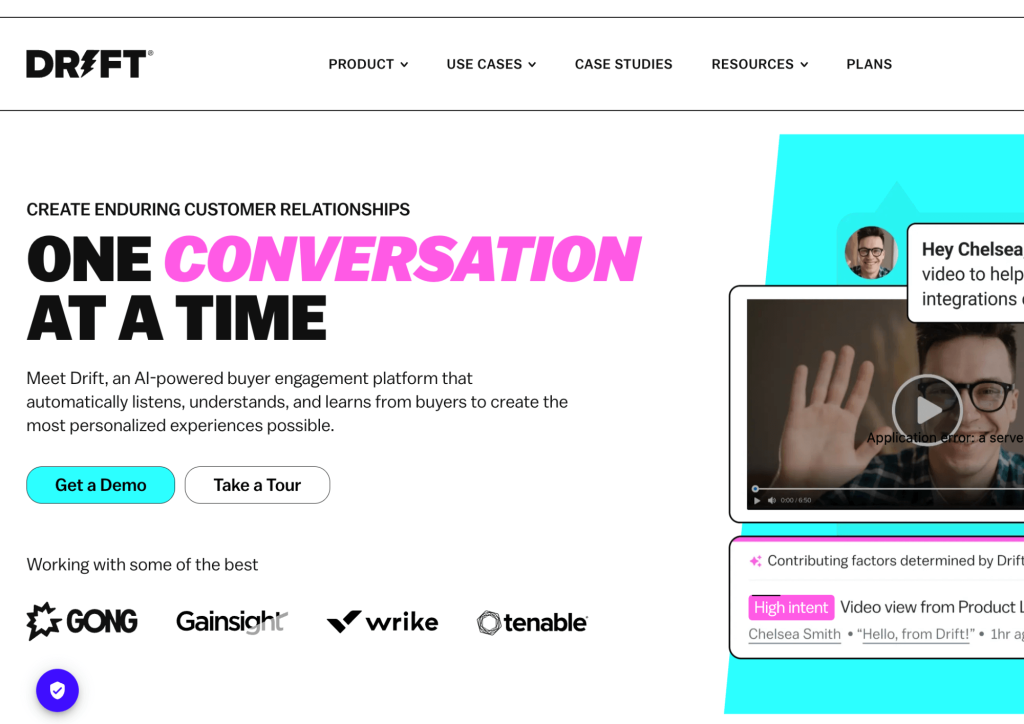
Drift specializes in conversational marketing, helping businesses generate leads through AI-driven chatbots and personalized messaging. It’s particularly effective for driving conversions and building customer relationships.
- Key Features:
- AI chatbots for lead qualification and engagement.
- Integration with marketing and CRM tools.
- Customizable chat workflows for specific user journeys.
- Real-time conversation tracking and analytics.
- Advantages:
- Enhances lead generation with conversational AI.
- Reduces friction in customer interactions.
- Offers tailored experiences for website visitors.
- Provides actionable insights to improve engagement.
- Disadvantages:
- Higher price point compared to similar tools.
- Best suited for businesses heavily focused on chat-based interactions.
Pricing: Free basic plan available; paid plans start at $2,500/year.
Tools for A/B Testing and Conversion Rate Optimization
Optimizely – Experimentation and Personalization
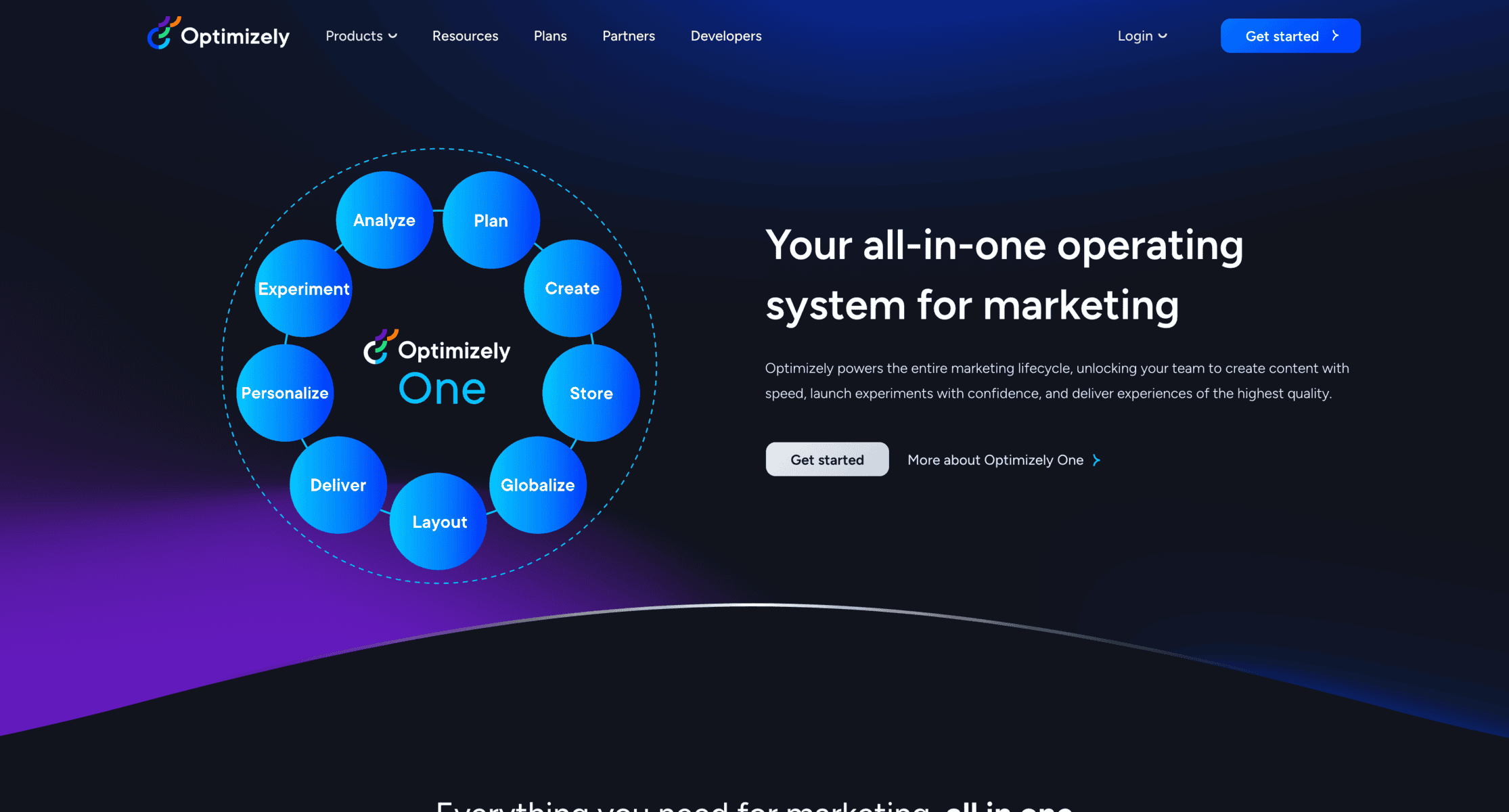
Optimizely is a leading platform for A/B testing and experimentation, allowing businesses to optimize their websites and digital experiences through data-driven testing. Its advanced features make it suitable for enterprises looking to enhance their conversion rates.
- Key Features:
- A/B and multivariate testing for websites and apps.
- AI-driven personalization for user-specific content.
- Visual editor for implementing changes without coding.
- Real-time analytics to track experiment performance.
- Advantages:
- Provides robust tools for optimizing user experiences.
- Offers personalization features to increase engagement.
- Supports large-scale experiments with detailed analytics.
- Easy to integrate with existing tools like Google Analytics.
- Key Features:
- Disadvantages:
- Premium pricing limits accessibility for smaller businesses.
- Advanced features require technical expertise to utilize fully.
Pricing: Custom pricing based on business needs; enterprise-focused.
VWO – Optimize Messaging and Design
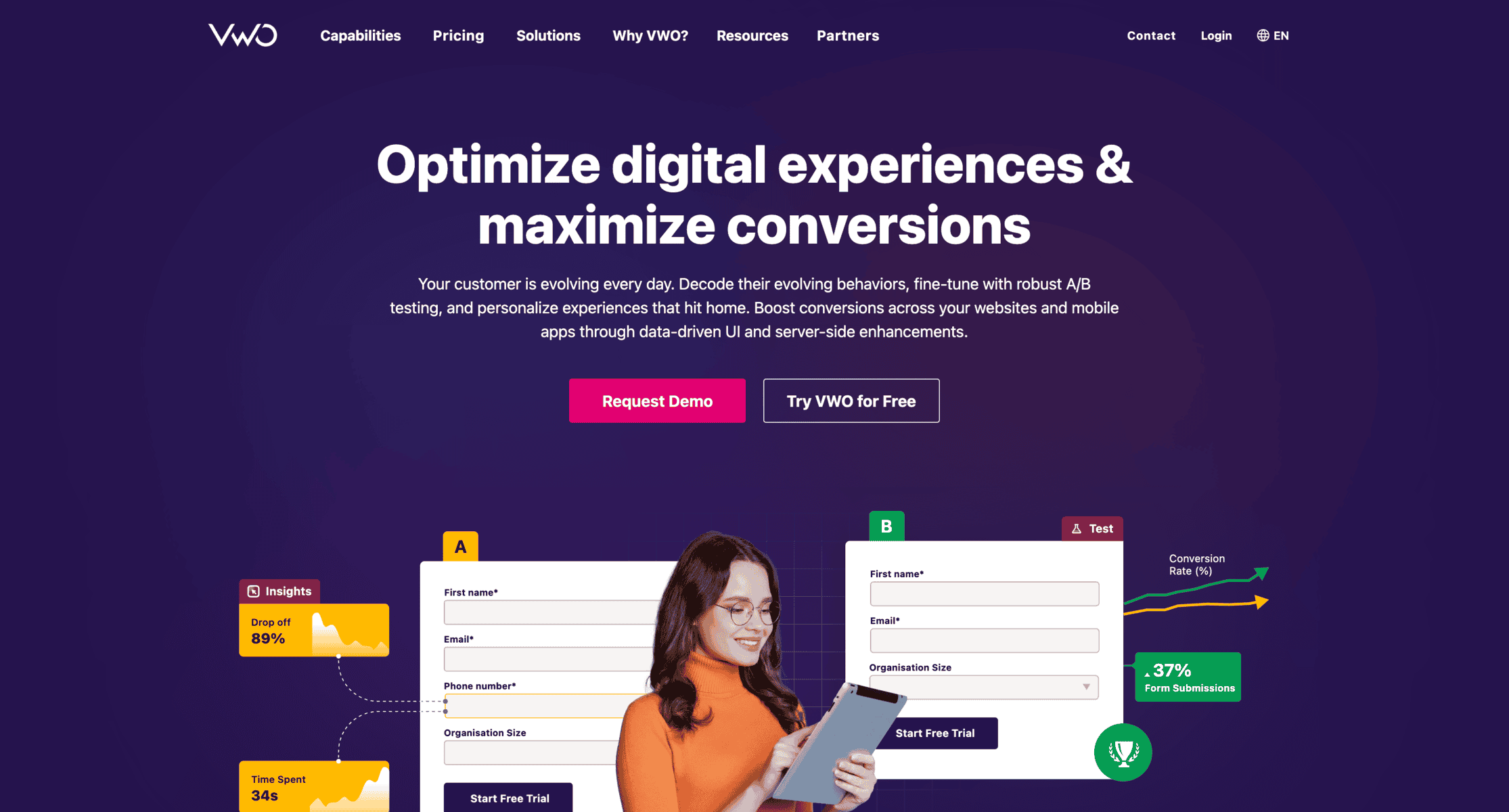
VWO (Visual Website Optimizer) offers a comprehensive platform for conducting A/B testing and improving user experiences. It focuses on helping businesses refine messaging, design, and website functionality to maximize conversions.
- Key Features:
- A/B, split URL, and multivariate testing capabilities.
- Heatmaps and session recordings for user behavior analysis.
- Personalization tools for targeting specific audience segments.
- Integrated reporting with detailed insights.
- Advantages:
- Easy-to-use interface for setting up tests quickly.
- Combines testing with behavioral analytics for a complete picture.
- Offers powerful targeting for personalization.
- Scalable for both small and large businesses.
- Disadvantages:
- Pricing can be high for advanced features.
- Some features, like personalization, may require technical support.
Pricing: Starts at $199/month for small teams; enterprise plans available.
Customer.io – Targeted Campaigns Based on User Behavior
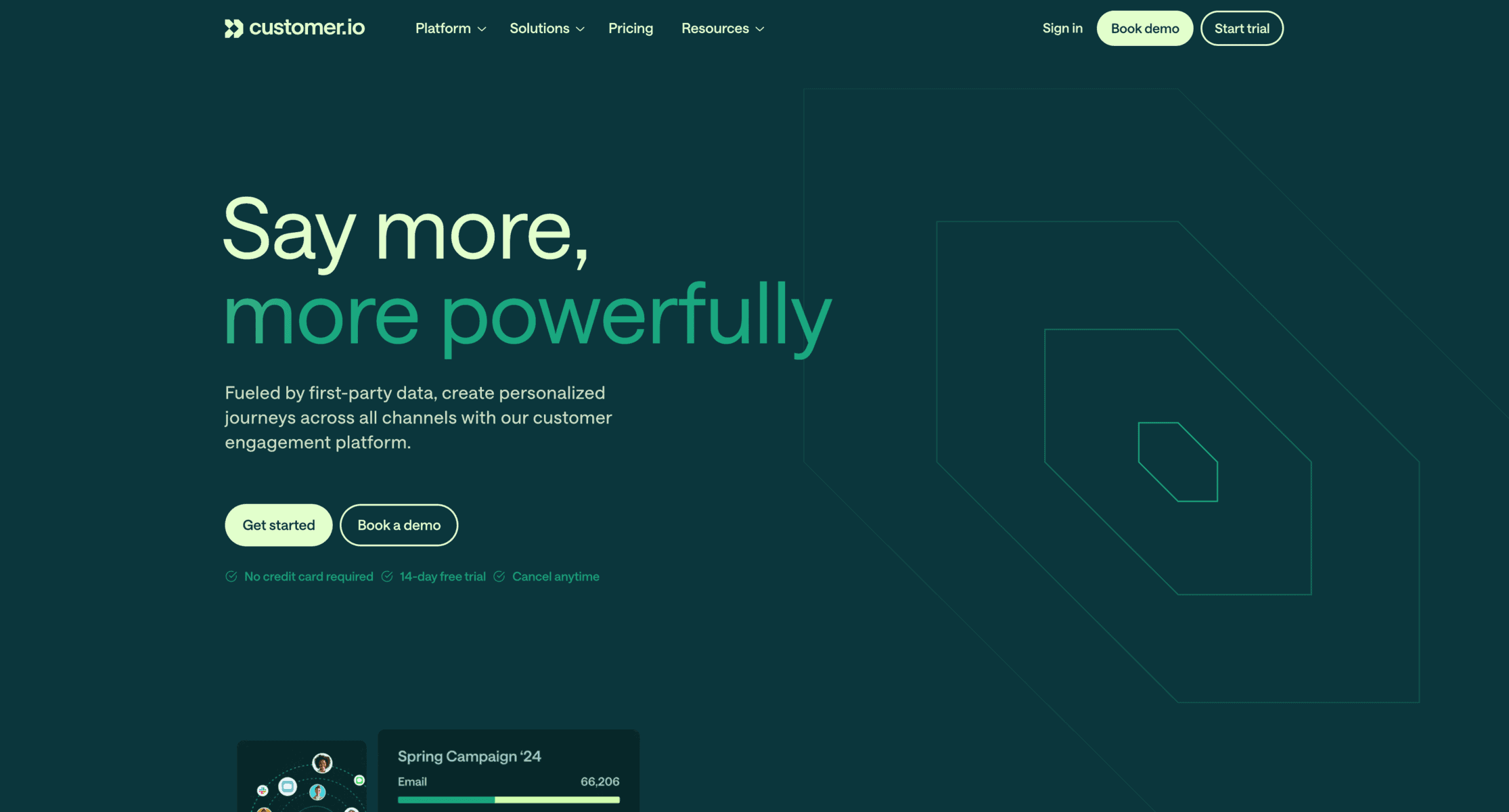
Customer.io focuses on behavioral marketing by enabling businesses to create targeted campaigns based on user activity. Its flexible automation system allows marketers to deliver highly personalized messaging.
- Key Features:
- Behavioral triggers for automating campaigns.
- Email, SMS, and push notification integrations.
- Advanced segmentation for audience targeting.
- Real-time analytics to measure campaign effectiveness.
- Advantages:
- Improves engagement with personalized, behavior-driven campaigns.
- Supports multi-channel communication.
- Intuitive interface for building workflows.
- Affordable entry-level pricing for smaller teams.
- Disadvantages:
- Limited templates for beginners.
- Requires integration with external tools for broader analytics.
Pricing: Starts at $100/month, scaling with usage and features.
Tools for Communicating Insights
Miro – Collaborative Online Whiteboard
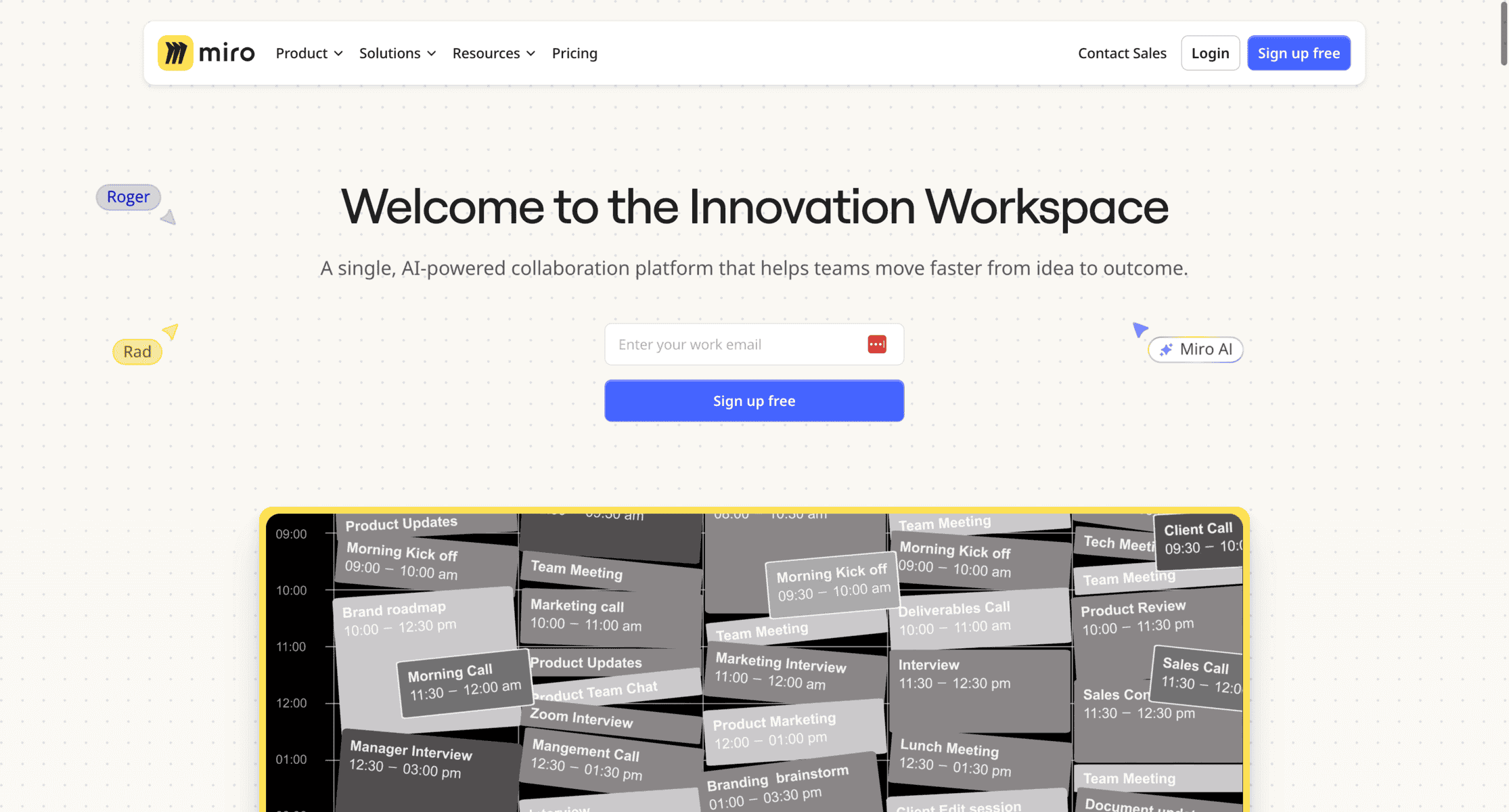
Miro is a versatile online whiteboard tool that helps teams visually organize and share insights. It’s particularly effective for brainstorming sessions, planning strategies, and presenting data in an interactive way.
- Key Features:
- Collaborative whiteboard with real-time editing.
- Pre-built templates for project planning and data visualization.
- Integration with tools like Slack, Asana, and Google Workspace.
- Unlimited canvas for creative and detailed presentations.
- Advantages:
- Encourages team collaboration with interactive features.
- Ideal for visually communicating complex ideas.
- Works well for remote teams with real-time updates.
- Easy-to-use interface for users of all skill levels.
- Disadvantages:
- Limited functionality in the free version.
- Can become cluttered with excessive inputs.
- Pricing: Free plan available; paid plans start at $8/user/month.
Visme – Create and Share Visual Reports
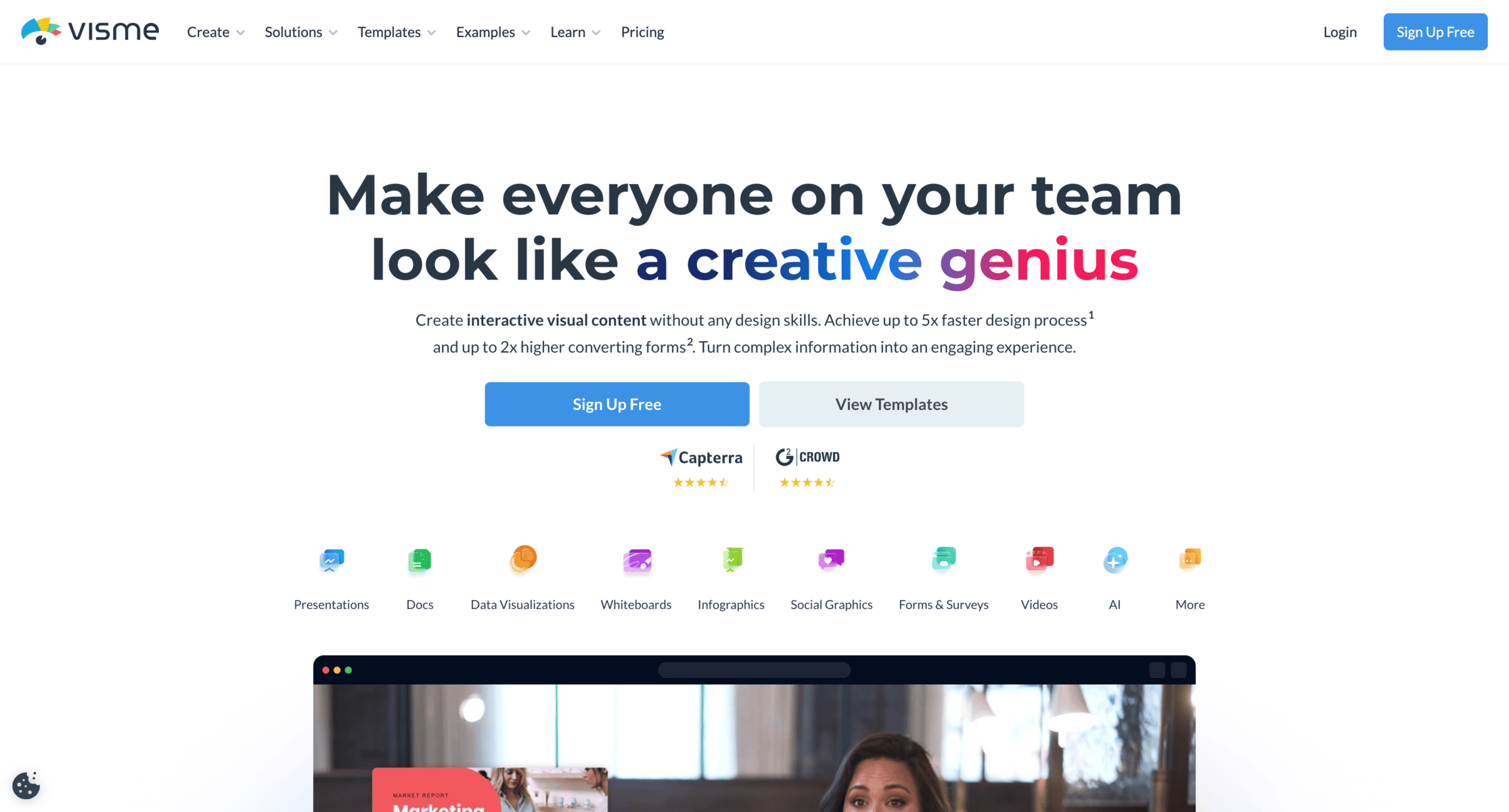
Visme is a design tool tailored for creating professional reports, infographics, and presentations. It’s perfect for marketers who want to turn insights into visually appealing and shareable formats.
- Key Features:
- Drag-and-drop editor with a variety of templates.
- Interactive features like embedded links, polls, and animations.
- Data visualization tools for charts and graphs.
- Export options for multiple formats, including PDF and HTML.
- Advantages:
- Makes data visually engaging and easy to understand.
- Suitable for creating branded, polished reports.
- User-friendly interface with minimal learning curve.
- Offers templates for a variety of marketing use cases.
- Disadvantages:
- Advanced features are locked behind premium plans.
- Limited customization options for certain templates.
- Pricing: Free plan available; premium plans start at $15/month.
Slidebean – AI-Powered Presentation Creation
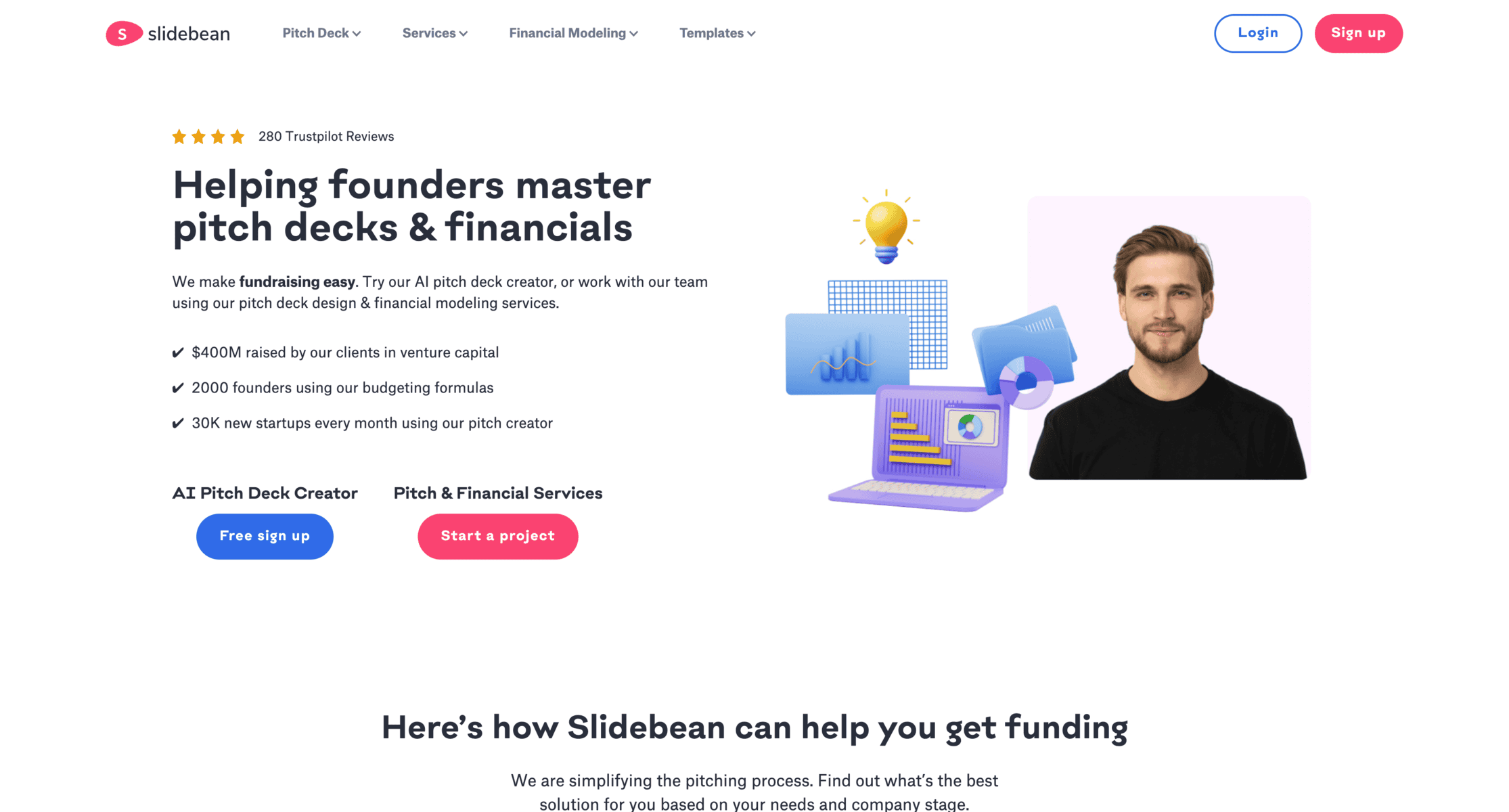
Slidebean is an innovative tool that uses AI to help create compelling presentations quickly. It’s an excellent choice for marketers needing professional slides for meetings or campaigns without spending hours designing them.
- Key Features:
- AI-driven slide arrangement and design suggestions.
- Templates tailored for marketing, sales, and product pitches.
- Collaboration tools for team edits.
- Integration with analytics to track presentation engagement.
- Advantages:
- Saves time by automating the slide creation process.
- Ensures professional designs with minimal effort.
- Offers flexibility for different presentation types.
- Includes analytics for monitoring audience interaction.
- Disadvantages:
- Limited creative freedom compared to traditional design tools.
- Higher pricing for advanced features.
- Pricing: Free basic plan; premium plans start at $96/year.
Data Analysis and Visualization Tools
Tableau – Interactive Dashboards and Visualizations
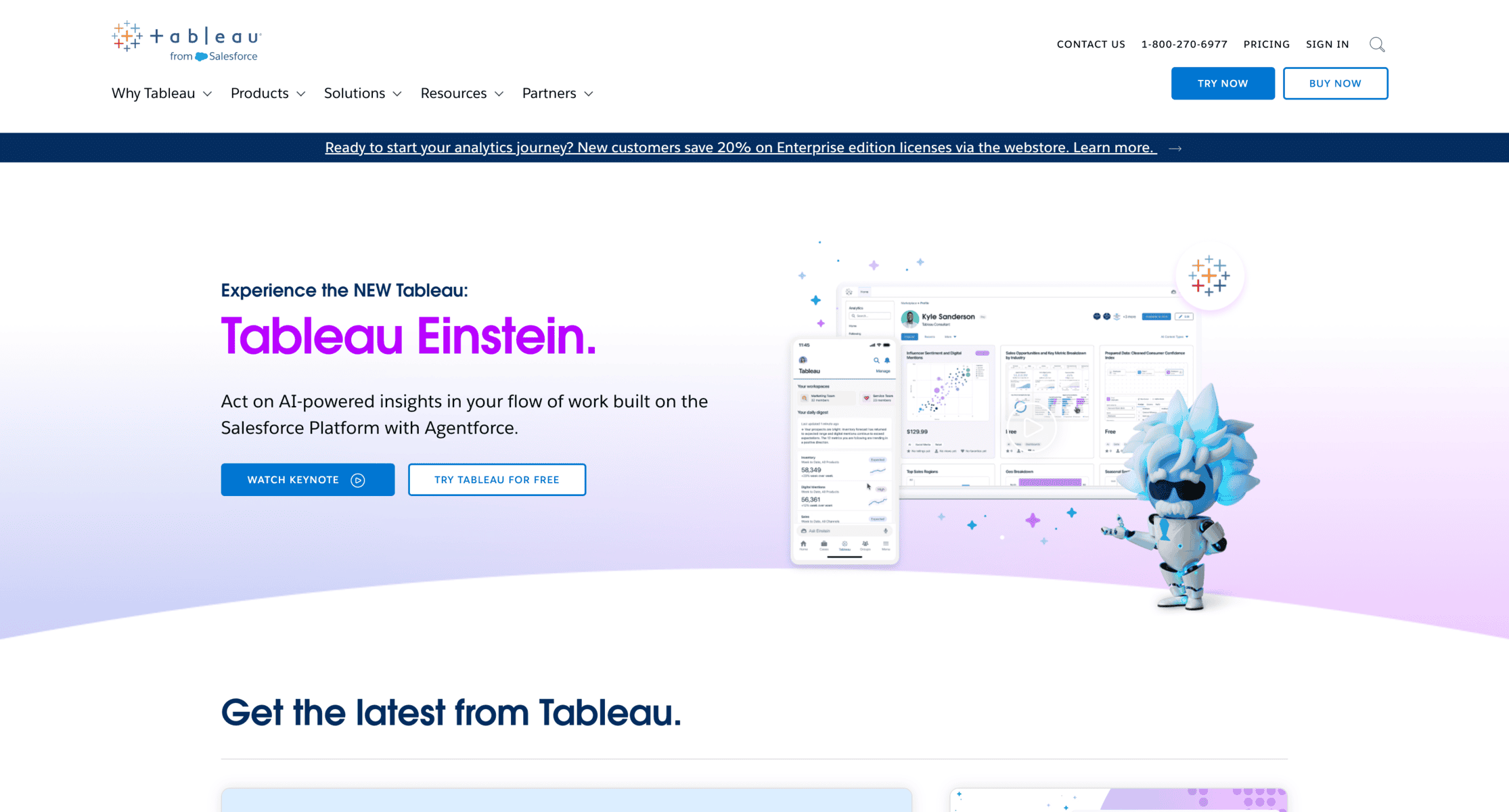
Tableau is a powerful data visualization tool that helps businesses transform complex data into easily understandable dashboards. It’s widely used for tracking marketing performance and identifying trends.
- Key Features:
- Drag-and-drop functionality for creating visual dashboards.
- Integration with various data sources like Excel, Salesforce, and Google Analytics.
- Advanced analytics for forecasting and trend analysis.
- Real-time collaboration and sharing options.
- Advantages:
- Simplifies complex data for non-technical users.
- Customizable dashboards tailored to business needs.
- Enhances decision-making with clear visual insights.
- Scalable for teams of all sizes.
- Disadvantages:
- Steeper learning curve for advanced features.
- High licensing costs for small businesses.
Pricing: Starts at $70/user/month for Tableau Creator.
Zoho Analytics – Collaborative Data Reporting
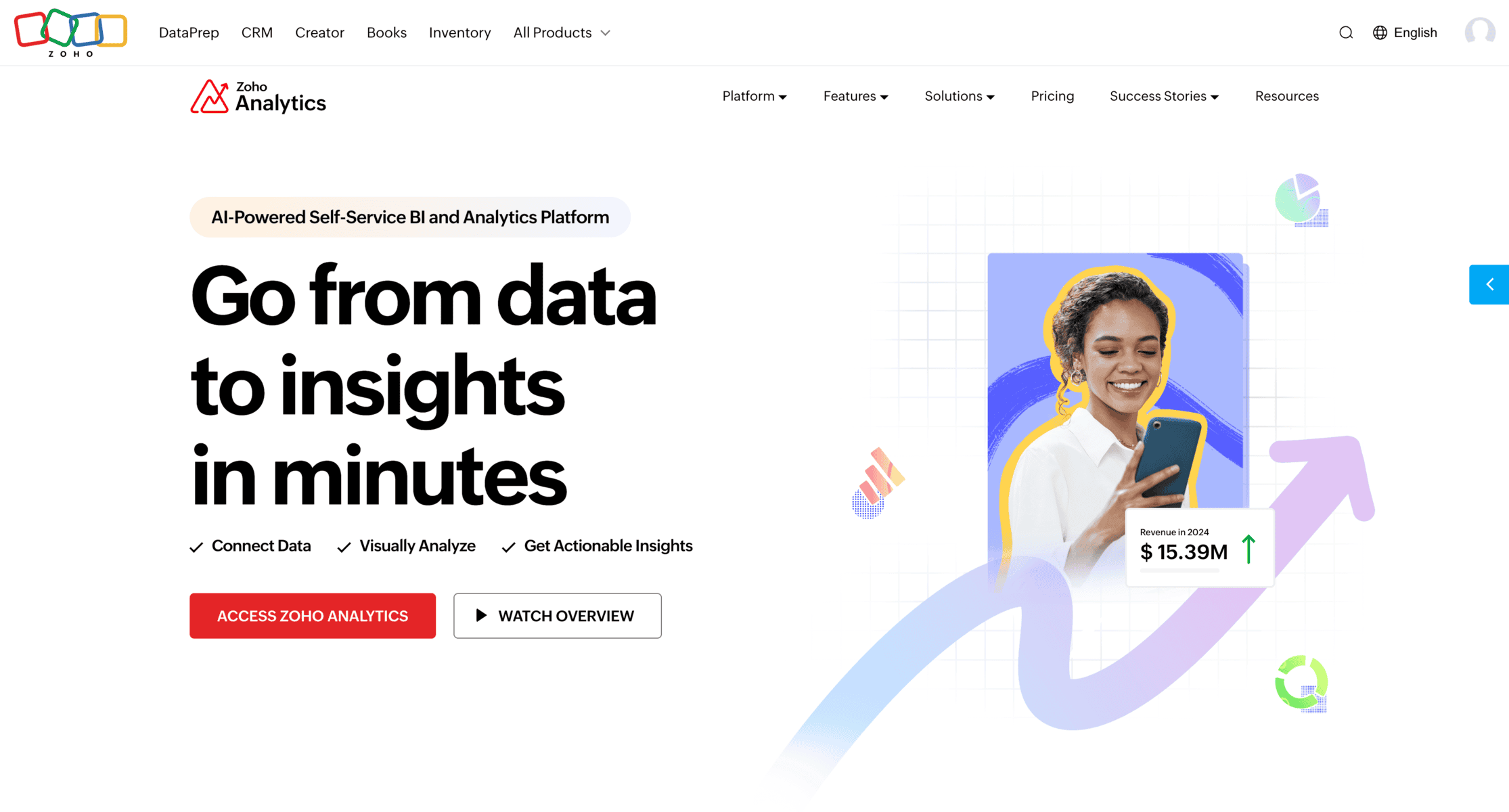
Zoho Analytics is a budget-friendly tool for small to medium-sized businesses that need to analyze marketing data and create collaborative reports. Its simplicity and affordability make it a popular choice for teams.
- Key Features:
- Pre-built marketing templates and dashboards.
- AI-powered insights through Zoho’s AI assistant, Zia.
- Integration with CRM, social media, and email platforms.
- Collaborative report-sharing capabilities.
- Advantages:
- Affordable for smaller businesses with robust features.
- User-friendly interface ideal for non-technical users.
- AI-powered insights for faster decision-making.
- Supports integrations across Zoho’s ecosystem and other tools.
- Disadvantages:
- Limited features compared to premium tools like Tableau.
- Advanced customization may be restricted.
Pricing: Starts at $24/month for two users.
Cometly – Precision Ad Tracking
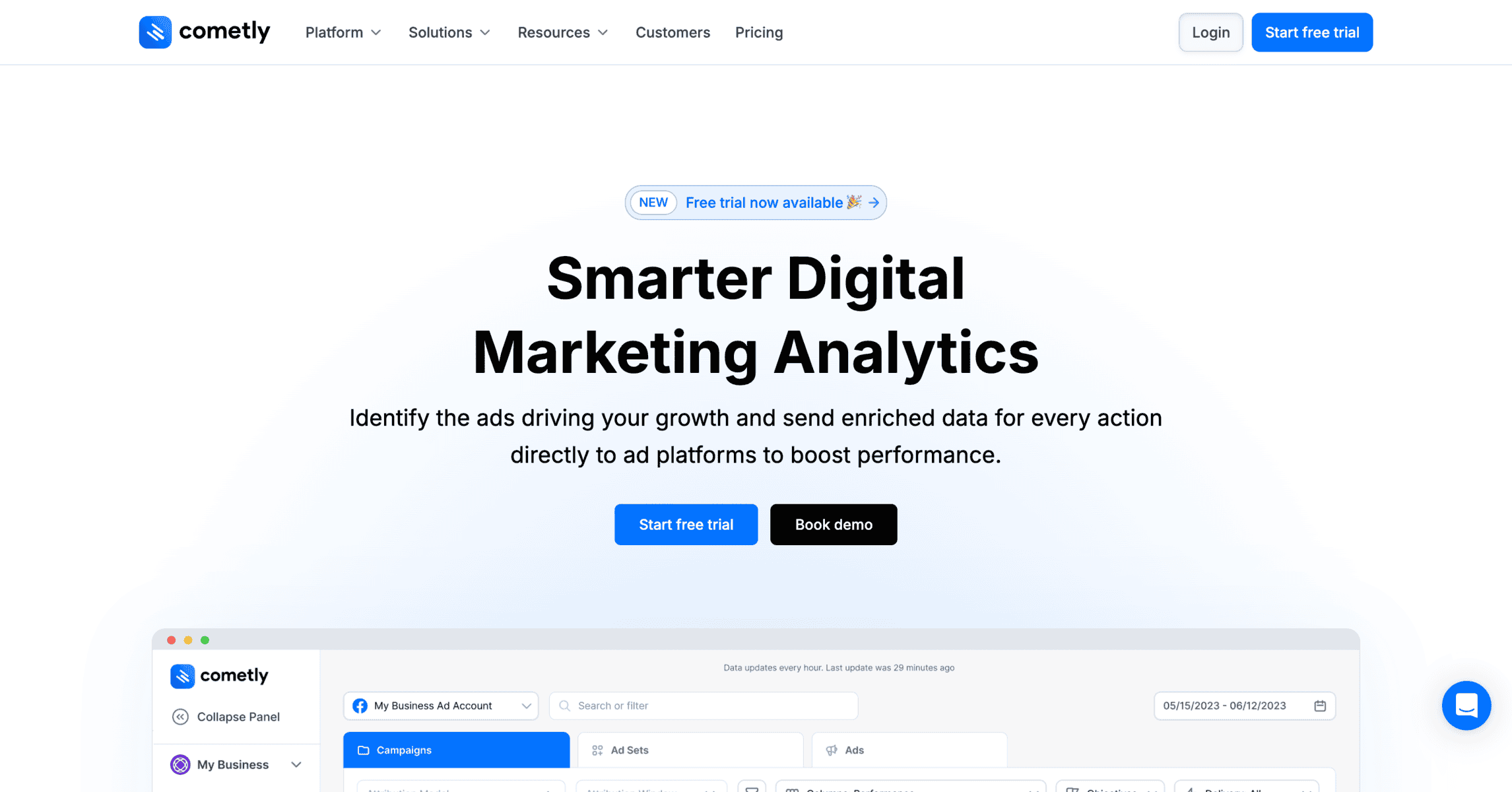
I’ve tested a lot of marketing attribution software, and Cometly stands out for its ability to track ad performance with pinpoint accuracy. If you’re running paid campaigns across multiple platforms, knowing exactly where your conversions come from is crucial. Cometly eliminates the guesswork, helping marketers optimize their ad spend and scale their efforts with confidence.
Why Cometly Excels at Marketing Attribution
- Real-Time Ad Tracking – Instantly see which ads drive revenue and which are burning your budget.
- Multi-Touch Attribution – Understand the full customer journey, not just the last-click conversion.
- Seamless Integrations – Works with Facebook, TikTok, Google Ads, and other major platforms.
- Automated ROI Analysis – Know exactly how much you’re earning for every dollar spent.
Potential Drawbacks
- Limited Organic Tracking – Designed for paid ads, so it’s not an all-in-one marketing analytics tool.
- Platform Focus – Best suited for performance marketers managing paid acquisition, not broader marketing insights.
💰 Pricing: Starts at $199/month for the Lite plan
Looker – User-Friendly Data Exploration
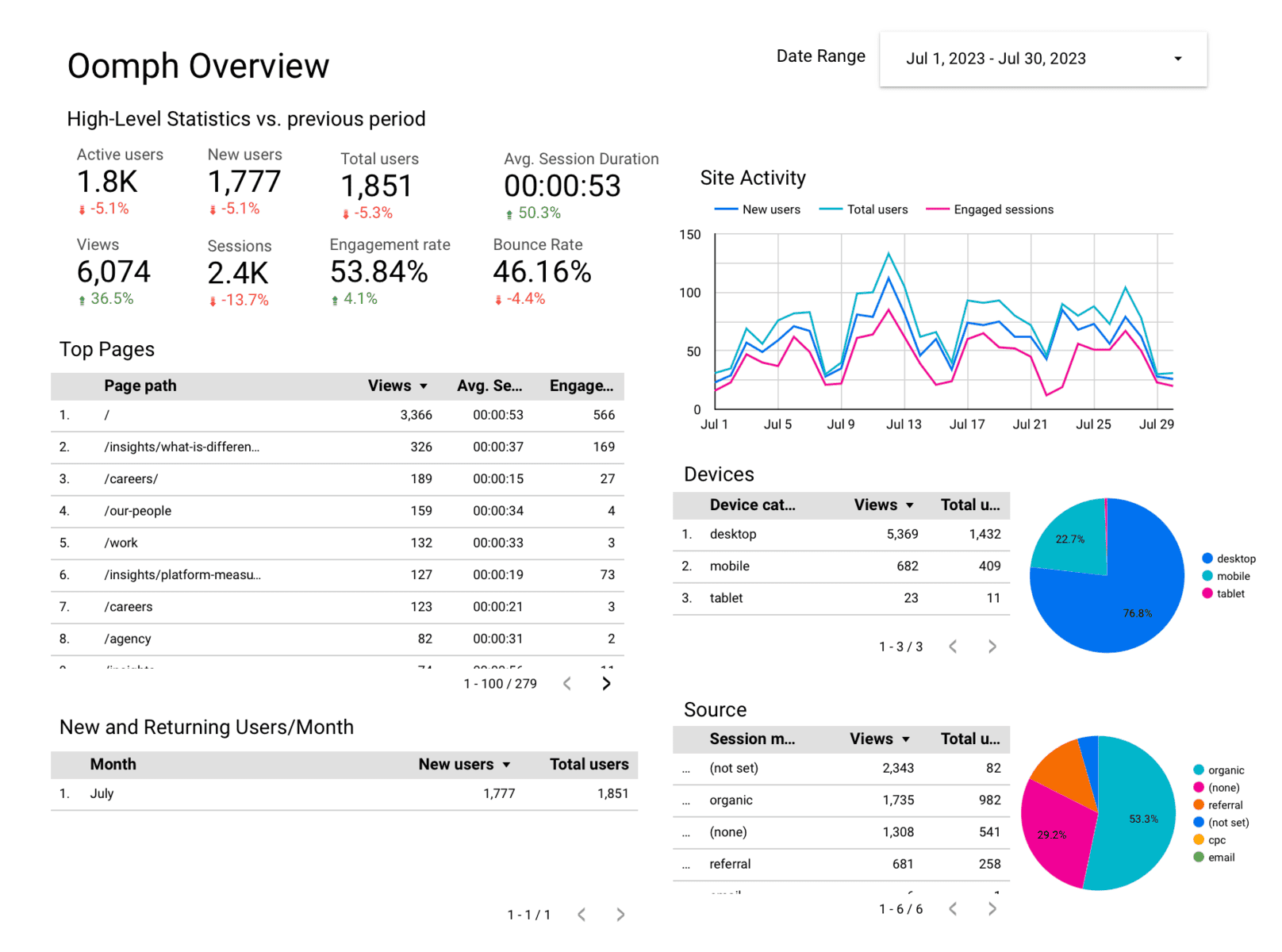
Looker is a modern business intelligence tool that enables teams to explore and analyze data with ease. Its cloud-based infrastructure integrates seamlessly with marketing and analytics platforms.
- Key Features:
- Data modeling with LookML for tailored analytics.
- Cloud-native design for real-time data access.
- Pre-built templates for marketing performance reports.
- Integration with Google Cloud and third-party tools.
- Advantages:
- User-friendly interface for exploring and visualizing data.
- Flexible for teams with diverse data sources.
- Encourages collaboration through shared dashboards.
- Ideal for businesses leveraging cloud platforms.
- Disadvantages:
- Requires technical setup for advanced customizations.
- Pricing is opaque and may be high for smaller teams.
Pricing: Custom pricing based on business size and needs.
Evaluating Product Marketing Tools
Assessing Product Market Fit Tools
Before making your final selection, consider how each tool can help you understand and validate your product’s market fit. Look for features that track user engagement, gather actionable feedback, and provide behavioral analytics. These insights are critical for determining whether your product meets market demands and continuously evolves with customer needs.
Checklist for Choosing the Right Tools
Selecting the best product marketing tools requires careful consideration of your team’s needs, budget, and objectives. Use the following checklist to guide your decision:
- Define Goals: Clearly identify the specific marketing tasks you need the tool to address (e.g., automation, analytics, or content creation).
- Key Features: Look for features that align with your marketing objectives, such as integration capabilities, user-friendly interfaces, or scalability.
- Budget: Compare the tool’s pricing with your budget and evaluate its cost-effectiveness, including any hidden costs for add-ons or integrations.
- User Reviews: Research feedback from other businesses in your industry to gauge satisfaction and common challenges.
- Support and Resources: Ensure the tool provides strong customer support, training, and documentation for a smooth onboarding experience.
- Trial or Demo: Opt for tools that offer free trials or demos to test compatibility with your workflow.
Free vs. Paid Tools – What’s Right for You?
The decision between free and paid tools depends on your business size, objectives, and resources.
- Free Tools:
- Advantages: Ideal for startups or small businesses with tight budgets. Offers basic functionalities that can address immediate needs.
- Disadvantages: Often limited in features, scalability, and customer support. Free versions may lack advanced analytics or automation options.
- Paid Tools:
- Advantages: Comprehensive features, better integration, and robust support make paid tools suitable for growing businesses. Many also provide advanced analytics and scalability.
- Disadvantages: Higher upfront costs, especially for premium or enterprise plans. May include fees for additional users or integrations.
Evaluate your team’s priorities to determine whether a mix of free and paid tools might offer the best balance between cost and functionality.
Trends in Product Marketing Tools
Hyper-Personalization Through Behavioral Data
Product marketing tools are moving toward hyper-personalization by leveraging behavioral data at an unprecedented scale. It’s no longer about segmenting audiences based on broad categories like demographics — tools now analyze micro-interactions, such as how long a user hovers over a product or which blog posts they revisit. This allows marketers to craft uniquely tailored messages and offers that feel personal, increasing engagement rates significantly.
AI-Powered Creative Content Assistance
Forget manually brainstorming taglines or A/B testing email subject lines for weeks. Advanced product marketing tools now integrate AI to assist with creative content generation. From suggesting blog post ideas to automatically creating social ads optimized for conversions, these tools are becoming essential for marketers looking to scale their creative output without increasing costs.
Real-Time Market Insights and Alerts
In a fast-paced market, being reactive isn’t enough. Newer tools now offer real-time competitive insights and market trend alerts. Whether a competitor launches a new product, lowers prices, or shifts their ad strategy, marketers can get notified instantly. This allows brands to pivot campaigns, update messaging, or even capitalize on trends before competitors gain traction.
Simplification of Multi-Channel Campaigns
Managing multiple platforms like email, TikTok, Google Ads, and LinkedIn can be overwhelming. The newest tools simplify multi-channel campaigns by offering unified dashboards and automation flows. Instead of juggling separate tools for each platform, marketers can control all campaigns — from ad placement to analytics — in one place.
Features of Product Marketing Tools
Predictive Behavior Modeling
Advanced tools now use machine learning to predict how likely a customer is to make a purchase, churn, or upgrade their subscription. These insights help marketers allocate resources effectively, focusing on high-value customers and leads.Scenario-Based Campaign Testing
Beyond traditional A/B testing, tools are now embracing scenario-based testing. Marketers can simulate how a campaign might perform under different market conditions, such as fluctuating ad costs or competitor launches, helping them prepare for real-world situations.Visual Journey Mapping
Mapping the customer journey is critical, but it’s often a static process. Modern tools now offer dynamic, visual customer journey maps that update in real time as customers move through different touchpoints. This helps marketers spot drop-offs and optimize campaigns instantly.Gamification Features for Engagement
To capture attention in crowded markets, tools now offer gamification capabilities. Whether it’s creating interactive quizzes, loyalty programs with rewards, or contests, these features encourage engagement and make campaigns more memorable.Collaborative Campaign Dashboards
Collaboration is becoming a top priority. New tools offer shared dashboards where marketing teams, designers, and even external partners can work together in real time, reducing back-and-forth emails and improving campaign efficiency.
Benefits of Product Marketing Tools
Accelerated Time-to-Market
With tools that streamline campaign workflows, businesses can reduce the time it takes to bring ideas to market. Automation, templated designs, and integrated approvals mean marketers spend less time on setup and more time executing.
Competitive Edge Through Innovation
The right product marketing tools don’t just help you catch up to competitors — they help you surpass them. Features like competitor tracking, real-time alerts, and predictive analytics ensure you’re always a step ahead.
Human-Centered Marketing
The best tools enable brands to understand their audience on a deeper, emotional level. Instead of focusing solely on sales metrics, modern tools emphasize metrics like sentiment analysis, helping businesses connect with customers on a more personal level.
Cost-Savings Beyond Campaigns
It’s not just about campaign ROI — these tools can cut costs across the board. Centralized platforms eliminate the need for multiple subscriptions, while automation saves valuable hours, translating to lower labor costs.
Costs & Pricing for Product Marketing Tools
| Plan Type | Average Price | Who It’s Best For | What Makes It Worthwhile |
|---|---|---|---|
| Freemium | $0–$15/month | Small teams testing tools | Great for exploring features before committing to a paid plan. Perfect for startups. |
| Growth Plans | $50–$150/month | Growing businesses needing scale | Includes advanced segmentation, multi-channel automation, and customizable workflows. |
| Enterprise | $500–$2000+/month | Large teams or global companies | Offers tailored features, dedicated support, and integrations with enterprise systems like ERPs and CRMs. |
Creative Pricing Trends
A growing number of product marketing platforms are moving toward pay-for-performance models, where businesses only pay based on campaign success metrics (e.g., conversions or engagement). This is ideal for small businesses looking to reduce upfront costs. Additionally, some platforms offer credits-based systems where you buy credits and use them as needed, creating more flexibility.
Frequently Asked Questions About Product Marketing Tools
What Are the Best Product Marketing Tools for Startups?
Startups often operate with limited resources, making it crucial to choose tools that provide maximum value at minimal cost. Here are some top recommendations:
- Canva: Free design tool for creating professional marketing materials like social media posts, presentations, and ads.
- Buffer: Affordable social media scheduling and analytics tool for maintaining an online presence.
- Hotjar: Offers free heatmaps to analyze user behavior and improve website design.
- HubSpot (Free CRM): Provides essential tools for customer relationship management and inbound marketing.
These tools are cost-effective, scalable, and ideal for startups that need a mix of usability and functionality.
How Do I Choose Tools That Align With My Team’s Needs?
To align tools with your team’s needs, follow these steps:
- Assess Current Processes: Identify inefficiencies or gaps in your existing marketing workflow.
- Involve Your Team: Gather feedback on which tools they find intuitive and which features they need the most.
- Set Clear Objectives: Define what you want the tool to achieve—automation, better collaboration, or data analysis.
- Test Compatibility: Ensure the tool integrates seamlessly with your existing systems.
- Evaluate Scalability: Choose tools that can grow with your business and adapt to future marketing needs.
By involving your team and prioritizing specific objectives, you can ensure the tools you select enhance productivity and collaboration.
How Can AI Tools Improve My Product Marketing Efforts?
AI tools have revolutionized product marketing by automating repetitive tasks, personalizing campaigns, and analyzing data at scale. Here’s how they can help:
- Content Creation: Tools like ChatGPT and Jasper generate marketing copy, saving time and maintaining brand consistency.
- Personalization: AI platforms like Kameleoon customize user experiences based on behavior and preferences.
- Market Analysis: AI-driven tools like Crayon and SEMrush identify trends, track competitors, and refine strategies.
- Efficiency: Automation reduces manual effort, allowing teams to focus on strategy and creativity.
